
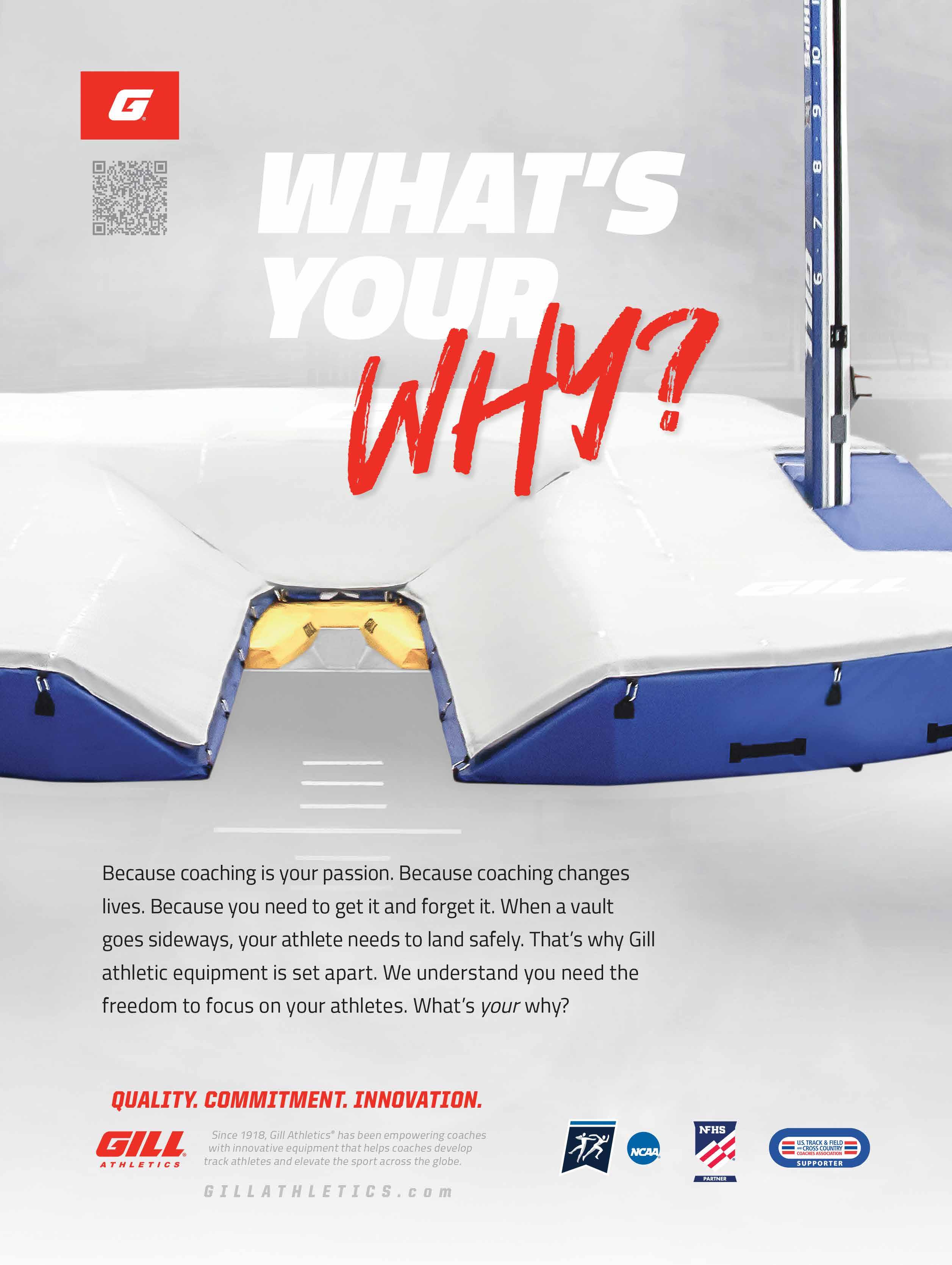 BY BOB MYERS
BY BOB MYERS
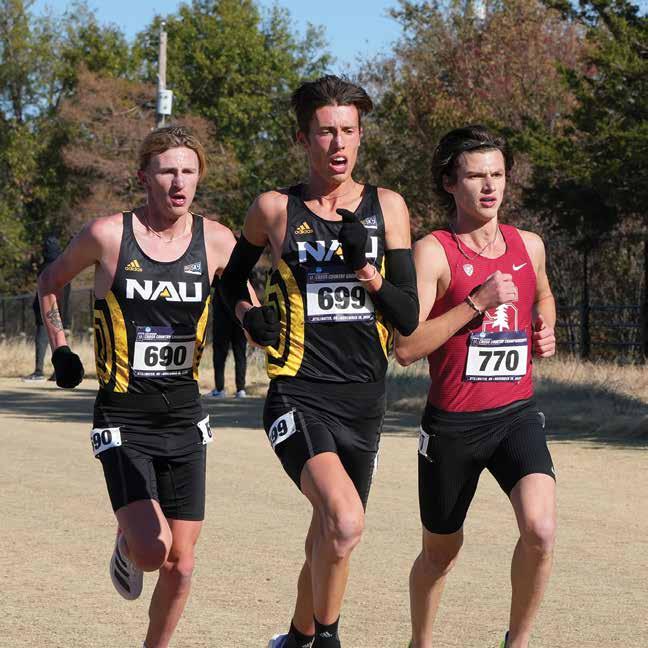


FEBRUARY 2023 techniques 1 IN EVERY ISSUE 6 USTFCCCA Presidents AWARDS 46 Cross Country National Award Winners FEATURES 8 Flying High...Safely Training theory applications to reduce high jump injuries
Contents Volume 16 Number 3 / February 2023
COVER:
TEXAS
THE
HIGH JUMP AT 6-5
SATURDAY,
2022.
14 28 6 18 Body and Balance Increasing sprint speed with the arms BY STEVE THOMAS 28 Running Periodization Part 2: Reverse linear periodization BY DR. JASON KARP 34 Breaking Barriers The mysterious alchemy of improvement BY STEPHEN LANE
ON THE
LAMARA DISTIN OF
A&M WINS
WOMEN’S
(1.96M) DURING THE 94TH CLYDE LITTLEFIELD TEXAS RELAYS,
MARCH 26,
PHOTOGRAPH BY KIRBY LEE IMAGE OF SPORT
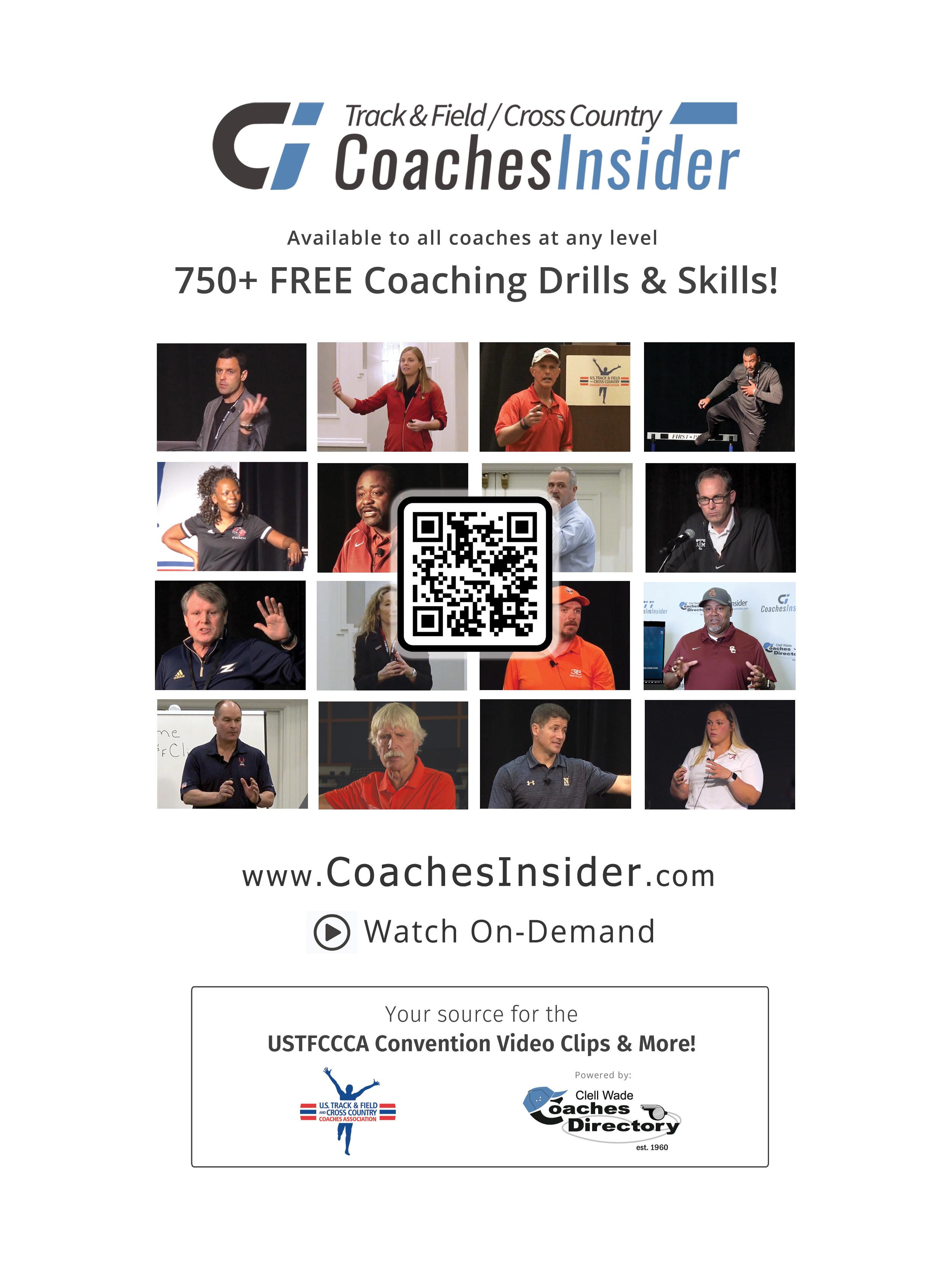
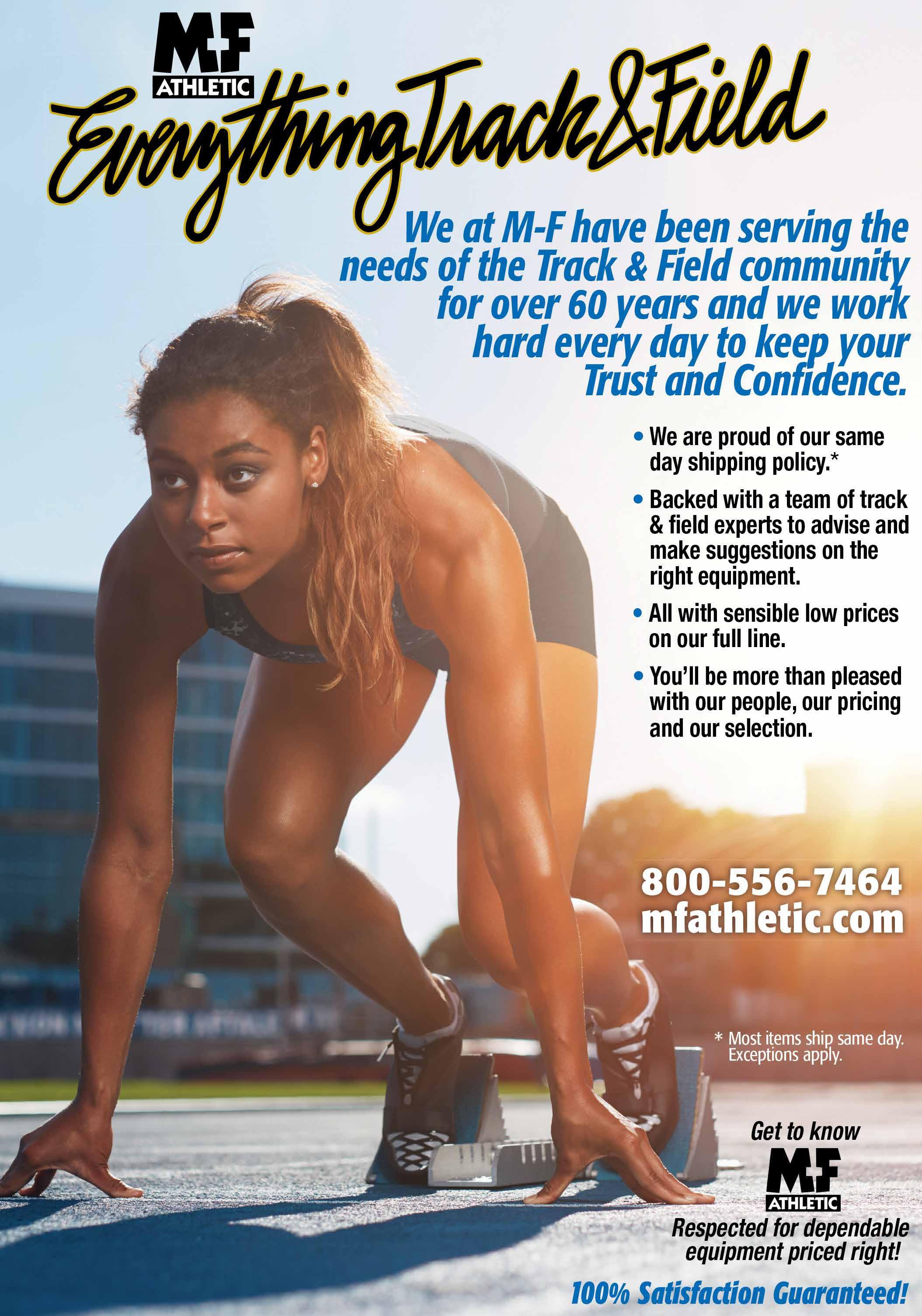


CARYL SMITH GILBERT
USTFCCCA President
Caryl Smith Gilbert is the Director of Men’s and Women’s Track & Field at the University of Georgia. Caryl can be reached at UGATFXC@sports.uga.edu
DIVISION PRESIDENTS
MARC DAVIS
Track & Field
Marc Davis is the Director of Track &Field and Cross Counry at Troy University. Marc can be reached at mddavis@troy.edu.
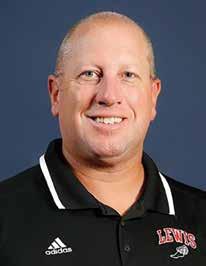
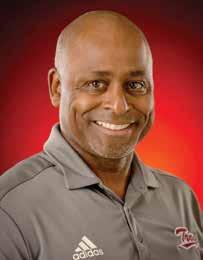
DANA SCHWARTING
Track
& Field
Dana Schwarting is the Head Men’s and Women’s Track & Field Coach at Lewis College. Dana can be reached at schwarda@ lewisu.edu


KENNETH COX
Track
& Field
Kenneth Cox is the Head Cross Country and Track & Field Coach at Birmingham-Southern College. Kenneth can be reached at kcox@bsc.edu
KEVIN SULLIVAN
Cross Country
Kevin Sullivan is the Director of Track and Field and Cross Country at the University of Michigan. Kevin can be reached at krsully@ umich.edu


CHRIS REED
Cross Country
Chris Reed is the Cross Country and Track & Field Associate Head Coach at Seattle Pacific University. Chris can be reached at chrisreed@spu.edu.
PUBLISHER
Sam Seemes
MEMBERSHIP SERVICES
Mary McInnis, Kelsey Nemeth, Kristina Taylor, Dave Svoboda, Adrian Wilson
COMMUNICATIONS
Lauren Ellsworth, Tom Lewis, Tyler Mayforth, Howard Willman
PHOTOGRAPHER
Kirby Lee
EDITORIAL BOARD
Tommy Badon, Scott Christensen, Todd Lane, Derek Yush
ART DIRECTOR Tiffani Reding Amedeo
PUBLISHED BY
Renaissance Publishing LLC 110 Veterans Memorial Blvd., Suite 123, Metairie, LA 70005 (504) 828-1380 myneworleans.com
MATTHEW BARREAU
Cross Country
Matthew Barreau is the Head Men’s and Women’s Cross Country Coach at Lewis and Clark College. Matthew can be reached at barreau@lclark.edu

MIKE COLLINS
Track & Field
Mike Collins is the Head Men’s and Women’s Cross Country and Track & Field Coach at LewisClark State College. Mike can be reached at mcollins@lcsc.edu

DEE BROWN
Track
& Field
Dee Brown is the Director of Track and Field and Cross Country at Iowa Central CC. Dee can be reached at brown_dee@iowacentral.edu
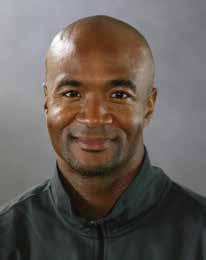
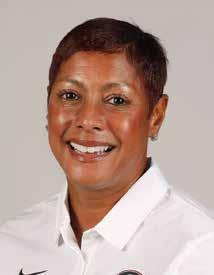
RYAN SOMMERS
Cross Country
Ryan Sommers is the Head Men’s and Women’s Cross Country Coach at Bethel (Ind.). Ryan can be reached at ryan.sommers@bethelcollege.edu
DON COX
Cross
Country
Don Cox is the Head Cross Country and Track & Field Coach at Cuyahoga CC. Don can be reached at donald. cox@tri-c.edu
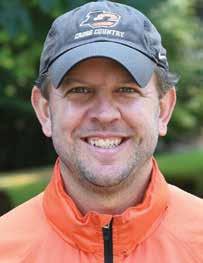
USTFCCCA National Office
1100 Poydras Street, Suite 1750 New Orleans, LA 70163 Phone: 504-599-8900 Website: ustfccca.org
If you would like to submit content for, or advertise your business in Techniques, please contact 504-599-8906 or techniques@ustfccca.org.
Techniques (ISSN 1939-3849) is published quarterly in February, May, August and November by the U.S. Track & Field and Cross Country Coaches Association. Copyright 2023. All rights reserved. No part of this publication may be reproduced in any manner, in whole or in part, without the permission of the publisher. techniques is not responsible for unsolicited manuscripts, photos and artwork even if accompanied by a self-addressed stamped envelope. The opinions expressed in techniques are those of the authors and do not necessarily reflect the view of the magazines’ managers or owners. Periodical Postage Paid at New Orleans La and Additional Entry Offices. POSTMASTER: Send address changes to: USTFCCCA, PO Box 55969, Metairie, LA 70055-5969.
6 techniques FEBRUARY 2023
USTFCCCA PRESIDENT
NCAA DIVISION I
NCAA DIVISION II
NCAA DIVISION III
NJCAA
NAIA

Flying

8 techniques FEBRUARY 2023
High...Safely Training theory applications to reduce high jump injuries
Most common high jump injuries have been well documented and include the take-off knee, back, lower leg and foot injuries. Learning from the injury documentation and acknowledging the take-off forces (rotational and linear) that impact the high jumper (up to 5.6 x the jumpers body weight-Milan Coh-2010 research), it is prudent to design a training program to withstand these extreme forces.
In following the Stress-Adaptation Theory, first documented by Dr. Hans Selye (1950), it is important to systematically reinforce these potential injury areas of a high jumper’s body that repeatedly need to resist these forces without succumbing to injuries, either chronic or acute.
Following Selye’s basic research were two noted researchers and training theorists, Matveyev (USSR) and Harre (GDR) who, in the 1960s and ‘70s, applied Selye’s basic research into more useable training theories. They applied work-to-rest ratios to the training of athletes and to setting up training cycles where work (training) and rest were theoretically quantified. Next, in the 1970s and ‘80s, Bompa (Canada), Dick (UK), Gambetta (USA), Winkler (USA), Pfaff (USA) and Lopez (PUR) further applied training theories into daily training patterns as they apply to athletes. Their works have been instrumental in applying volume and intensity levels for varied training ages of athletes.
Dealing with these high jump forces, and factoring in the total stress (training, school, work, social pressures, etc.) on the individual jumper, is critical to adapt the program to resist injury.
ASSESSMENTS TO ACQUIRE DATA THAT COULD LEAD TO POTENTIAL INJURIES
Before actual programming and training is initiated, an assessment model with protocols must be planned, along with all training stakeholders/performance team members, for the high jumper. These stakeholders can include medical staff, sport scientists, strength staff, event coach(es) or others that have direct contact with the planning of training (nutritionist, sport psychologist, massage therapist, chiropractor, etc.). A complete medical history should be researched along with injury history and an analysis of anatomical/congenital/genetic or somatotype issues.
Joint balance testing, stability testing, mobility testing, and strength assessments, along with an annual athletic physical, should be the first steps in the assessment of each individual high jumper. Assessments should go from general to specific, with
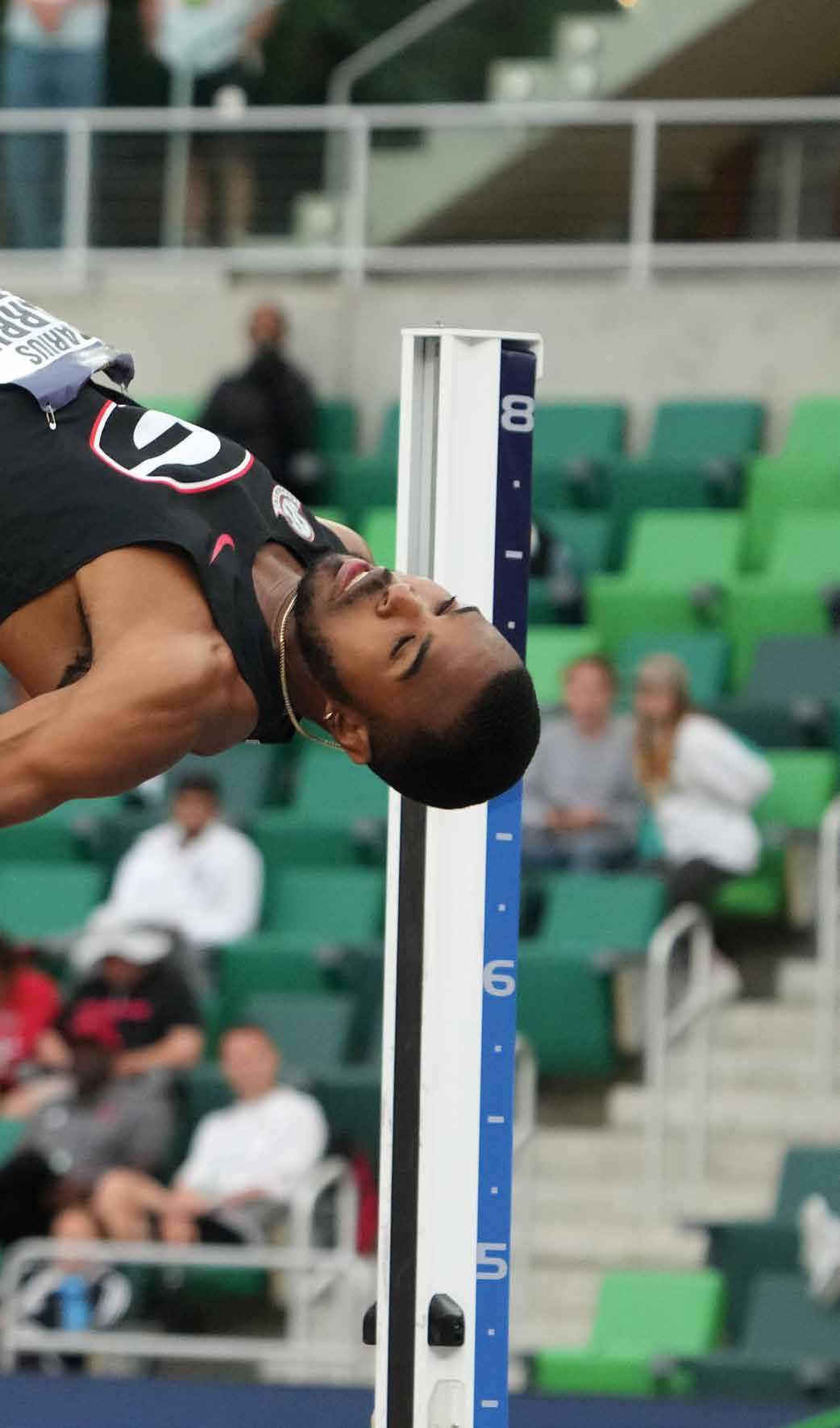
FEBRUARY 2023 techniques 9
KIRBY
LEE IMAGE OF SPORT
high jump specific assessments of speed, strength, power and technique being the last portion of the testing.
After the assessments are complete, all stakeholders should contribute to appropriate portions of the individually-specific training program. The athlete should also be involved in this process to ensure training prehab, rehab, rest, recovery and restoration are an integral part of the program. These are critical parts of training to ensure success of the overall program.
It is important that one person takes the lead in assessing the total stress on the high jumper. In most cases, this is the event coach as that person is usually the one who has the most consistent long-term relationship and contact hours with the individual jumper.
TRAINING ADAPTATIONS-GENERAL
Once the training is initiated, it is still critically important to constantly watch, listen and communicate with each jumper as to any potential issues that might occur within each training unit. The best way to ascertain this information is to ensure a strong relationship with each jumper based on open, honest and transparent communication. Developing a relationship based on mutual respect allows the coach to accurately assess the total stress on the jumper and must be taken into account if the training program is to be optimized. Additionally, understanding the psychological make-up (motivation, goals, etc.) of the jumper can help the coach understand issues that could stress the jumper, possibly leading to injury.
A highly motivated jumper may not always communicate an injury. Having a strong, positive relationship with the jumper can help to avert any potential injury, as the athlete feels open to communication with the coach or other stakeholders.
BIOMECHANICS
Technical coaching plays a big role in reducing injuries. Understanding the biomechanics of the event and coaching 360 degrees (coaching from various angles) to fully see the strengths and weaknesses of each jumper’s technique is an important aspect of reducing injuries. This is best accomplished via one-on-one coaching, video review and enlisting other stakeholders and experts to assess technical issues which may lead to injury. Study of pertinent publications written by coaches and scientists on the biome-
chanics of high jumping is also advisable.
MOTOR LEARNING
It is critical when coaching technique that the coach optimizes cueing and feedback from the athlete. Most jumpers can only accommodate several different technical cues per jump. In stressful situations, such as competitions, the jumper may only be able to focus on one technical change. Offering too many technical changes at once has been found to be an inefficient way to modify an athlete’s technique (Schexnayder-2018). The coach can try various cues for the same outcome, if necessary, until the athlete is able to make the specific technical change. Sometimes finding the right cue enables the athlete to make the connection to execute the change. Depending on the jumper’s optimal learning method, it may be prudent to try audio, video or kinesthetic cues to make a change.
CONSIDERATIONS FOR PROGRAM DEVELOPMENT
There are other factors in developing a program for each jumper which can help reduce the chance of an acute or chronic injury. One factor is knowing the training age of the athlete, or the number of years the athlete has been training generally and specifically for the high jump. Training background, such as types of training and quality and quantity of training, also needs to be considered when constructing an individual program. In developing the training program, the coach and/or other stakeholders need to adjust the training based on knowledge of this information to individualize training.
Somatotype, percent fast-twitch (through testing or observation), injury history, current technical level, coordination history (multi-sport background and types of activities in the jumpers background), motivational make-up and total assumed stress (if they are a student, have a job, etc.) should always be considered in the program.
Planning recovery/rest/restoration or adaptation time into each part of the training plan is essential if any plan is to be a success. Planned rest, active rest, restoration and recovery needs to be programmed into each training unit, microcycle, mesocycle, phase, macrocycle, etc.
Considering the coaching of females or males makes a difference in creating the program for the high jumpers. It is generally accepted that women high jumpers need
more strength training while males need more speed-strength training to optimize their fitness.
Using proper teaching progressions for technical development is also a pedagogically useful way to develop technique. Proceeding through teaching or technical progressions too rapidly can cause not only a lack of development, but can cause an injury to occur.
The use of an appropriate warm-up to meet the objectives of the training unit is also an essential way to reduce acute injuries, but also to reduce chronic injuries. A specific warm-up is important to develop functional work capacity to provide appropriate fitness to reduce injuries. Variability of training, and especially lifting variability, can also lead to a higher level of injury resistance. Lifting variability (including various types of catches in Olympic lifts, single and double leg squats in various ways and variations of squats, step-ups, leg presses, etc.) is important in obtaining injury resistance and also leads better training results. Additionally, proper lifting mechanics are a huge part of injury resistance. If improper Olympic lifting and squatting techniques are not mechanically correct, the jumper is at higher risk of injuries. Avoiding rushing through to heavy weights without proper lifting technique is essential if injury resistance is a goal.
Planned hydration and proper nutrition are keys to prevent short or long term injuries from occurring. Hydration, nutrition and sleep (plus overall rest) are as critical as the training program if an athlete is to stay healthy.
Many of the chronic injuries that are documented for high jumpers occur when the volume and intensity curves of training cross. For the American collegiate athlete, this usually occurs in January, and perhaps again in March/April, depending on the competitive schedule and level of the jumper. During these at-risk periods, it is helpful to provide adequate rest to ensure adaptation to the training program.
As with any program, systematic progressions of load and intensities play a huge role in creating a healthy, stress and adaptation program for each athlete. Tracking volumes and intensities is critical to ensure smooth transitions from cycle to cycle.
DRILLS
Drills must be evaluated to ensure they
10 techniques FEBRUARY 2023 FLYING HIGH...SAFELY

are done mechanically correct and for the appropriate purpose. Far too often coaches use drills they have seen or heard of, but without proper purpose or mechanics. Drills should be placed in three basic categories: drills to develop improved technique, to improve specific high jump strength and to improve special strength. Special strengths can be used to rehab an injury, improve an assessed weakness or to prevent injuries. An example of special strength exercises are heel and ankle walks that can strengthen the lower leg, ankles and feet to prevent future injuries. Specific strength refers to adding load (extra weight) to the actual high jump motion.
PREHAB, REHAB, REST, ACTIVE REST, RESTORATION AND RECOVERY
What are the definitions of these terms?
Prehab - Treatment of a body part which has been injured in the past or is under stress from training that may be predisposed to injury.
Rehab - Treatment from medical staff to help the jumper recover from high levels of training or an injury.
Rest - Time off with no training in each training cycle or at the end of the season, such as during the transition phase at the end of the season. The actual amount of rest time is dependent on training age, background, etc.
Active Rest - Time off from high jump training. “Active” means activities in other sports such as basketball, volleyball, swimming, hiking, etc. which can be used to regenerate the athlete mentally and physically. Active rest activities are usually programmed after a rest period at the end of the season or after high loads in a micro- or mesocycle.
Restoration - Activities or supplements to help the athlete physically or psychologically overcome the soreness of hard training. Examples include the use of sauna, spa, steam or warm baths (in moderation and not right before a competition-dehydration should be avoided) and contrast baths. Easy swimming, massage or easy running on soft (grass) surfaces also helps the athlete recover from heavy lifting or intense sprinting. Chiropractic manipulation can also help the athlete recovery from high volumes or intensities of vertebral loading.
Recovery - An actual planned training unit to help the body recover from heavy training. For example, in the middle of a microcycle, tempo runs (slower runs with
minimal recovery time) can help the body recover from higher intensity speed or speed endurance. Psychological or mental recovery should also be planned. Training at different locations should help by inserting fun activities into the training cycle. A wellthought-out program has hard work and rest bouts. This will help the body be at its best, or peak at the right time physically and mentally.
OTHER PRAGMATIC WAYS TO PREVENT INJURIES
Some additional ways to reduce specific stresses which can lead to injuries include:
Doing 50% of the running workouts for the year on grass, some barefoot and some in flats, as opposed to sprint spikes on the track in all phases.
Doing 50% of running on the curve in both directions as opposed to just one direction.
Each day after training, practice a few minutes of spinal elongations either from hanging or inversions at a 20 degree angle from vertical.
Perform 20% of high jumping from the non-dominant leg.
Cool-downs should be specific to the training performed. Stretching and/or strides, along with contrast baths, etc. can be useful, depending on the type of training that day.
Recovery from highly intense training with lower intensity higher volume training.
Recovery from high volume training with low volume intense training.
Emphasize that the “little things” such as sleep, nutrition, hydration, psychological training, prehab, rehab, etc. are just as important as the physical training parts of the program.
Reduce training and increase rest if outside stressors are acting on the jumper, such as: final exams, social trauma, etc.
Make coordination training a year-round part of the program.
Use a longer or extended warm-up as weather conditions dictate or after a workout, which could lead to intense soreness.
Increase specific strength (loaded portions of the high jump motion) to supplement weight room strength as the season progresses.
Listen to each jumper every day to comprehend if any pain is more than training soreness, since this may be an indication of a potential injury.
Ascertain which learning style each ath-
lete possesses and use the dominant style in coaching, such as if a high jumper is a visual, auditory or a kinesthetic learner.
NUTRITION
Nutrition plays a huge role in injury prevention. A proper diet and adequate caloric intake protects the athlete from stress injuries and aides in the restoration process. Jumpers should be checked regularly (optimally 2 to 3 times per year), by using common blood assessment protocols to ensure they do not show any deficiencies, such as calcium or vitamin D. Longitudinal data from accurate body composition testing is also a useful tool to determine optimal competition weight, but should always be used along with nutritional counseling. Body composition testing, using reliable testing methods, should be performed at the initiation of the training year, at the end of the general preparation phase and several times during the competition phase. Group and individual nutritional education and counseling meetings with jumpers can prevent serious injuries and ensure that a jumper is not susceptible to eating disorders.
Supplements can be useful at times for jumpers, however, before any jumper begins a supplement, there should also be agreement from coaches and medical staff. Jumpers should never take a supplement without first getting permission from their coach and other performance team members. Supplements are very individualized and are not a “one size fits all” solution. Some over-the-counter supplements contain ingredients that are on the NCAA, USATF and World Athletics banned list, so care must be taken to supply appropriate medical oversight before taking any supplements.
CONTINUING EDUCATION FOR THE PERFORMANCE TEAM
A final recommendation for the prevention of injuries for high jumpers is that each member of the performance team should review and evaluate each injury to ascertain if it could have been prevented by a more effective training program. Input from all stakeholders, including the jumper, is critical if the program is to be improved each year. Additional continuing education to seek out the latest sport science and coaching research can help plan more effective training to reduce injuries in the future. As the old saying goes, “Twenty years of coaching experience is better than one year
12 techniques FEBRUARY 2023
FLYING HIGH...SAFELY
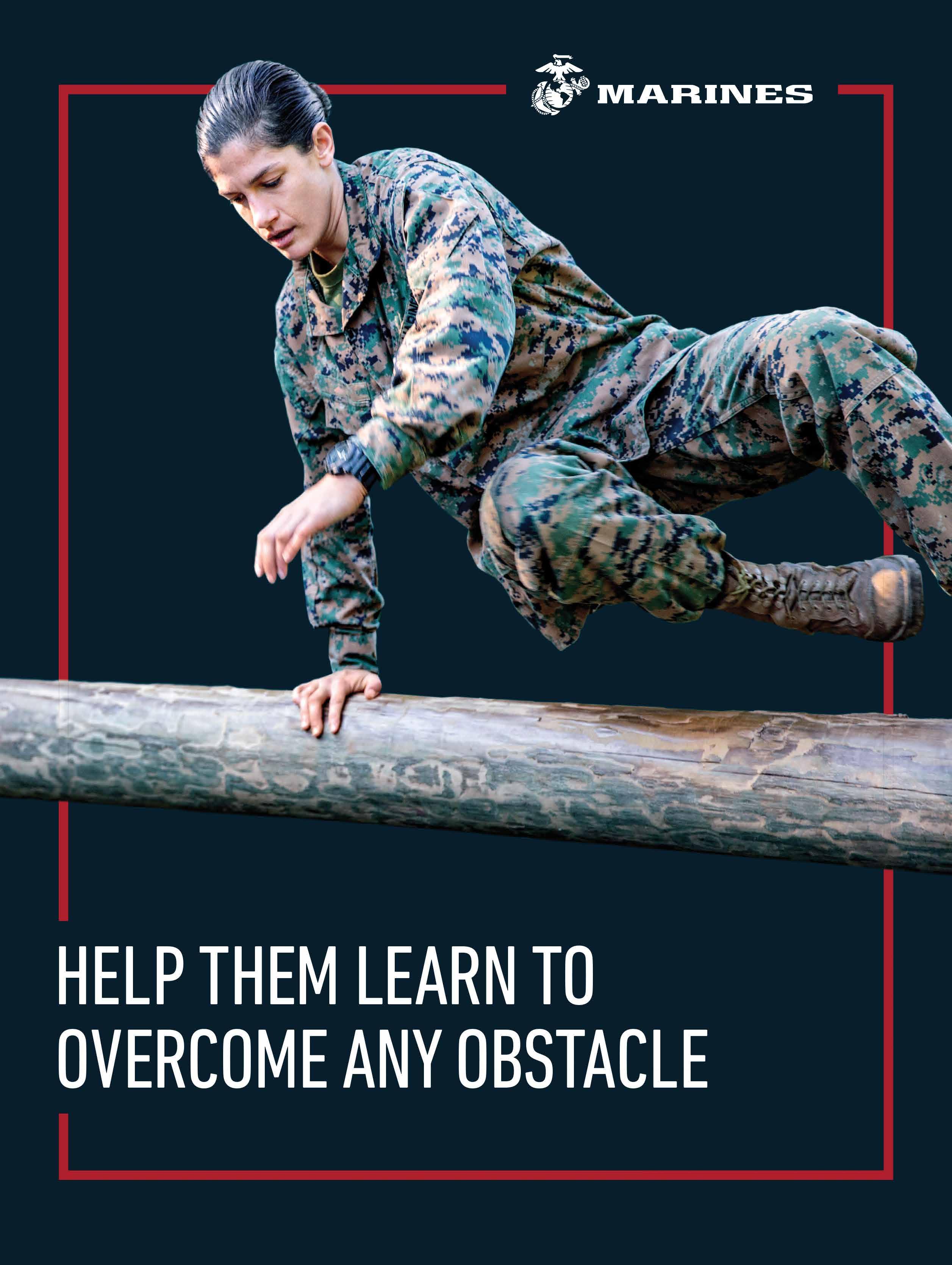
of coaching repeated 20 times”. Therefore, keeping abreast of research and training theory advances can be extremely helpful.
REFERENCES
Ae, M., Nagahara, R., Ohshima, Y., Koyama, H., Takamoto, M., & Shibayama, K. (2008) Biomechanical analysis of top three male high jumpers at the 2007 World Championships in Athletic. New Studies in Athletics, 23(2), 45-52.
Arampatzis, G., & Bruggemann, G. (1999). High Jump. Biomechanical Research Project Athens 1997.
Bompa, T. (1985). Theory and
Methodology of Training. Kendall/Hunt Publishing. Second Edition.
British Columbia Injury Research and Prevention Unit. (2018). British Columbia Children’s Hospital. Active and Safe Central. Brüggemann, G-P., & Glad, B. (1989). Scientific Research Project at the Games of the XXIVth Olympiad – Seoul 1988: final report. Monaco: International Athletic Foundation Conrad, A., & Ritzdorf, W. (1990). Scientific Research Project at the Games of the XXIVth Olympiad – Seoul 1988: final report. International Athletic Foundation, International Amateur Athletic Federation. Dapena, J. (2006). Scientific services proj-
ect – HIGH JUMP. Biomechanics Laboratory, Dept. of Kinesiology, Indiana University.
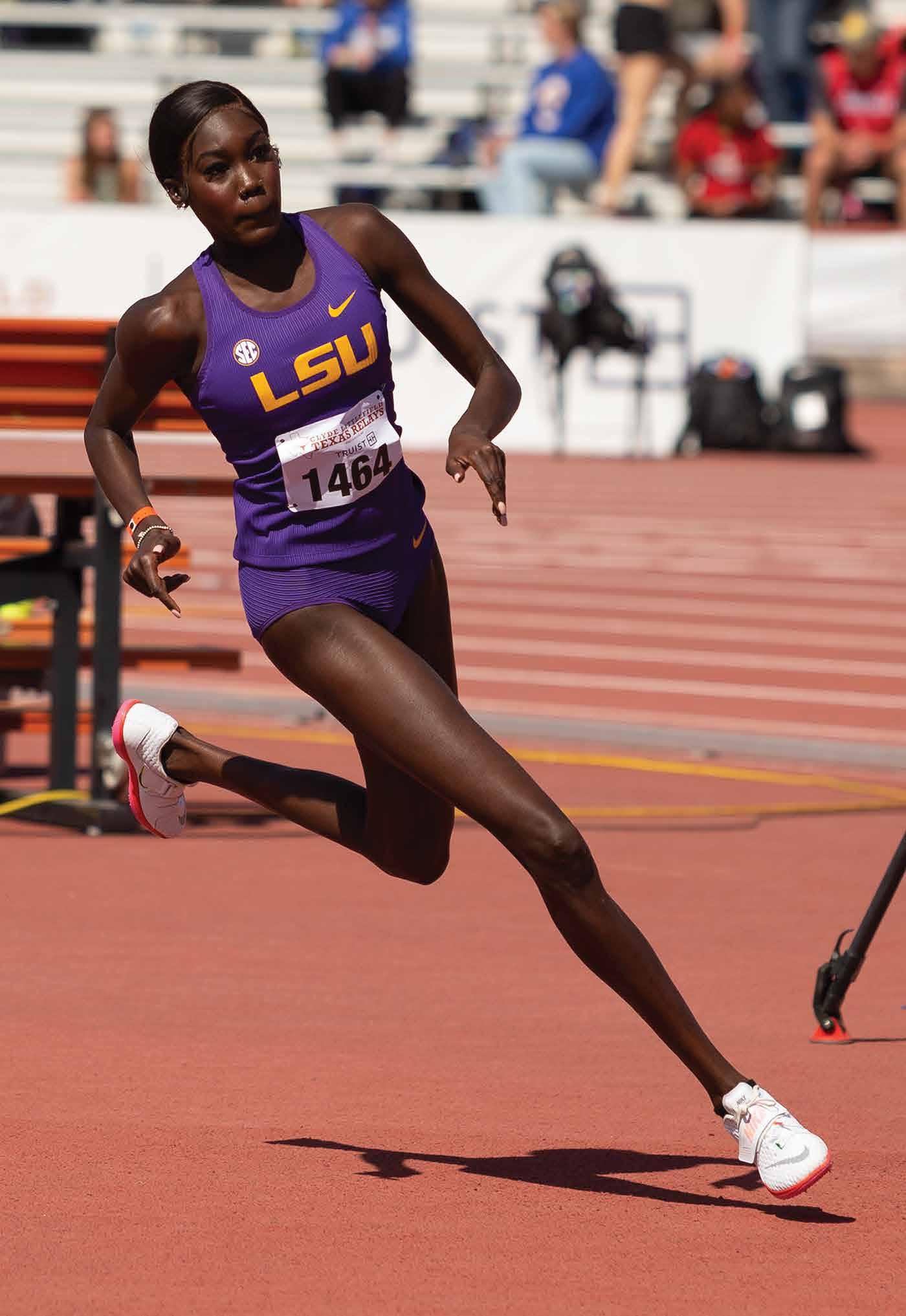
Dapena, J. (2000). The high jump. In: V. Zatsiorsky (Ed.), Biomechanics in Sport (pp. 285-311). Blackwell Science.
Dapena, J. (1997). Contributions of angular momentum and adding to the twist rotation in high jumping. Journal of Applied Biomechanics, 13, 239-253.
Deporte, E., & Van Gheluwe, B. (1989). Ground reaction forces in elite high jumping. Journal of Biomechanics, 22(10), 1002.
Dick, F. (1984). Training Theory. British Amateur Athletic Board Publishing.
Gambetta, V. (2006). Athletic Development-The Art and Science of Functional Sport Conditioning.
Harre, D. (1982). Principles of Sport Training. Sportverlag Berlin Publishing.
Isolehto, J., Virmavirta, M., Kyrolainen, H., & Komi, P. (2007). Biomechanical analysis of the high jump at the 2005 IAAF World Championships in Athletic. New Studies in Athletics, 22 (2), 17-27.
Lopez, V. (1970-2022). Various publications and articles.
Matveyev, L. (1981). Fundamentals of Sports Training. Progress Publishers-Moscow.
Myers, Robert. (1991). Restoration for Jumpers. Technical Bulletin-North American, Central American and Caribbean AreaWinter 1991 (Puerto Rico) & Athletics Science Bulletin. Jan-Feb. 1991 (USA).
Newman, Nick –Moderator (2018). Reducing and Managing Injuries. The Jumps Roundtable #2.
Pfaff, D. (2021). Dan Pfaff Training Philosophy. Runner Program Publishing. Runner Program Publishing.
Schexnayder, B (2018). Motor Learning. Techniques Magazine. May 2018, #4.
Selye, Hans. (1950-Jun 17). Stress and the General Adaptation Syndrome. British Medical Journal.
Winkler, G. (2009). Speed and Hurdles Training Philosophy
14 techniques FEBRUARY 2023
BOB MYERS HAS BEEN A COACH, A PROFESSOR, AN ATHLETIC DIRECTOR, A DEAN AND IS A HALL OF FAMER. HE IS CURRENTLY VOLUNTEER COACHING AT THE UNIVERSITY OF ARIZONA.
FLYING HIGH...SAFELY



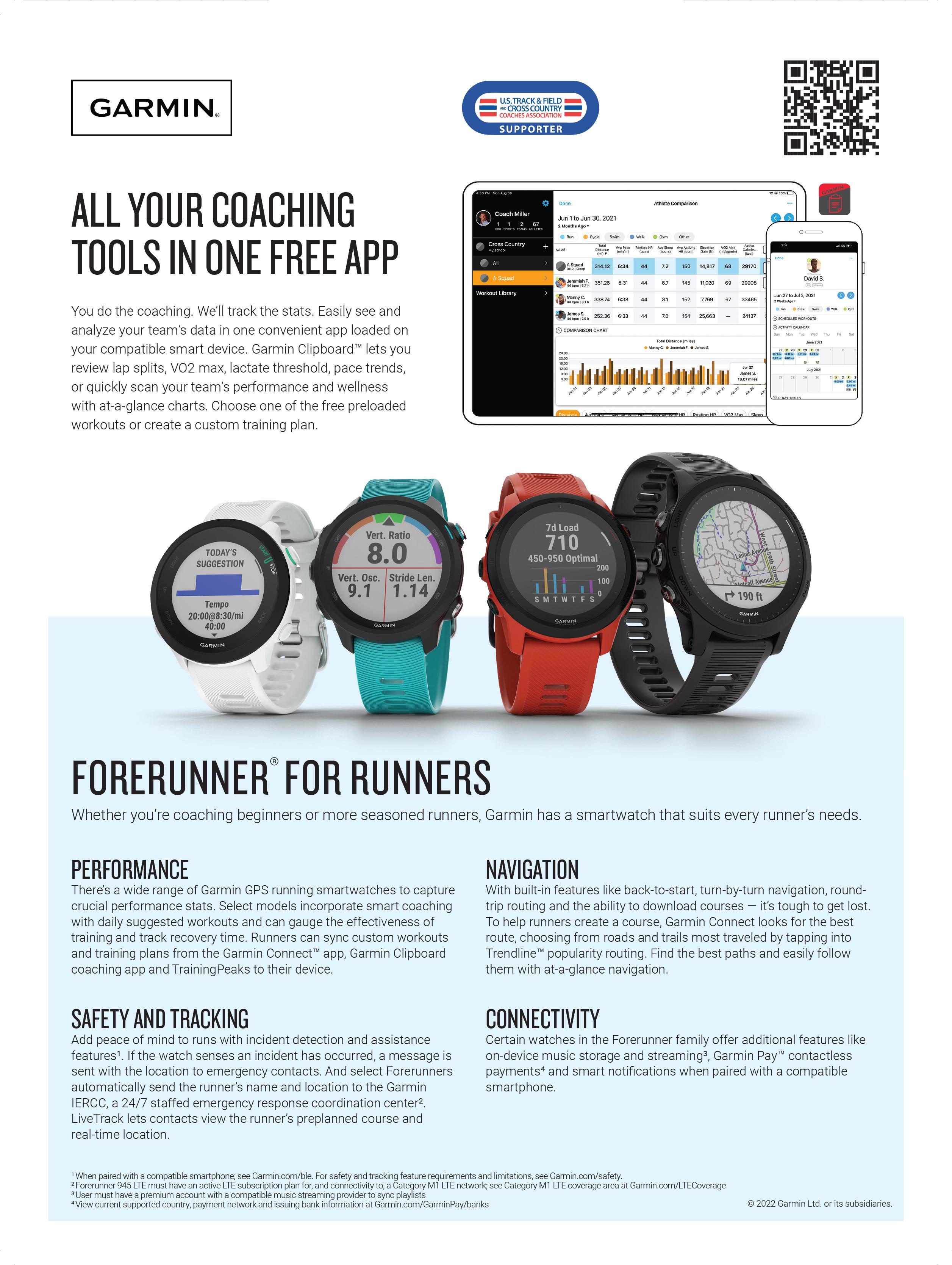

18 techniques FEBRUARY 2023 KIRBY LEE IMAGE OF SPORT
Body and Balance
Increasing sprint speed with the arms

Coaching Athletics (Track & Field) is about solving problems with movement. All correct movements will apply the greatest force in the shortest period of time. So, the solution to all problems in Athletics is maximum force generation as fast as possible. The first objective in Athletics is maximum force development. Once this is developed, speed of application becomes the priority.
The coach and sprinter must understand that speed is not a feeling, but a creation. Feeling speed by moving the arms and feet fast does not produce speed, it produces the feeling of speed. Speed is created by applying maximum force to the ground in the shortest time. In sprinting, the athlete has .08-.10 to maximize force into the ground.
Coaches must understand that the athlete runs on their legs, but they sprint with their arms. Force acts on the human body at the center of mass or center of gravity. It is a point in the body that the three planes (sagittal, coronal and transverse) intersect in the body. This point is not a constant point in the body because of the fluid internal make-up of the body. It is approximately at the second sacral level of the sacrum bone when standing with the arms at the side.
FEBRUARY 2023 techniques 19
About 10cm below the navel. It is slightly lower in women.
To teach sprinters how arms create force on the center of mass, have the sprinter stand with their hands at the hip joints. On your signal, have the sprinter drive their hands forward as fast as possible to the front of the body and stop them when their hands are at shoulder level. The sprinter will feel the center of mass move backwards (the hips move backwards) (Figure 1).
From the same starting position, have the sprinter drive their hands from the hip joints backward on your signal. The sprinter will feel the center of mass move forward in the body (the hips will thrust forward) (Figure 2). This simple exercise teaches the sprinter how the arms impact the center of mass, but more importantly, that the arms must be driven back behind the body to move the center of mass forward. Too much arm movement to the anterior side of the body (front side) moves the center of mass backward, away from the sprint direction.
The next thing that the sprinter must learn is the simple physics of levers. Long levers move through space slower, but generate more force. Shorter levers move through space faster, but generate less force. Again, sprinters want to feel speed instead of create speed. They do this by shortening the arms to 90 degrees (a shorter lever.) This allows the arms and feet to move faster, but at the same time reduces force into and out of the ground reducing stride length.
We run on our legs, but we sprint with our arms. Sprinting is a coordinated effort of the legs and arms. As the right leg goes forward, the right arm goes back. This is a natural occurrence, even in walking. This action and counteraction serve to complement one another and is Newton’s third law in action. The arm driving back produces forward motion of the lower body. The arms, used properly, will produce a great deal of impulse into and away from the ground. The blocking very quickly of the forward and backward arm action maximizes force. The forward arm block directs force into the ground, and the backward block directs force from the ground into the athlete’s center of mass.
The greater the sprinting speed, the more the back arm must clear a point well behind the center of mass. Sprinters need
this clearance, while distance runners will not have a big backward drive of the arms. The legs will respond to the arms by lifting higher with the bigger arm drive, creating a higher forward force. To best utilize the blocking action for the development of force, the back arm should not completely extend at the elbow. Some athletes require more elbow extension because of longer stride length.
Contrary to popular belief, the arms do not maintain the same 90 degrees during running. It ranges from a minimum of about 60 degrees at the front (Figure 3) and a maximum of about 140 degrees at the mid-point (Figure 4) of the arm swing during each stride. Emphasis is placed on driving the hands downward and backward (Figure 5). The hand should not cross the mid-plane of the body in the front. The elbow must not move past the body in the forward arm swing. This will cause the center of mass to move back and down. The hand must remain inside the elbow at all times to prevent unwanted twisting of the trunk. Excessive arm action is a sign of uneconomical motion and over-striding.
There are three phases of a sprint stride: (1) The Recovery Phase, (2) The Support Phase, and (3) Drive Phase. Each phase requires specific movements to maintain maximum speed.
The Recovery Phase: This phase begins as the support foot breaks contact with the ground. The hand is at the shoulder of the leg that is being retrieved. The signal to recover the leg is sent slightly prior to the foot leaving the ground. Better athletes minimize upper and lower leg extension at takeoff, minimizing ground contact time, thereby increasing stride frequency. The back leg does not fully straighten at the knee in the drive phase. The athlete must take the foot off the ground and not let forward momentum take the foot off the ground.
The hand must move first, not the elbow. The hand is driven down to the hip joint, through the area of the center of mass. If the elbow moves first, the hand will move back above the center of mass producing significantly less force for horizontal movement. The hand will be back earlier, stopping the thigh from reaching a parallel position in the drive phase. The thigh will stop moving forward when the arm stops moving back. The longer lever
of the hand driving down to the hip joint, gives the thigh time to reach the parallel position in the drive phase.
The thigh is flexed at the hip retrieving the extended back leg. At the same time, the leg is flexed at the knee, pulling the heel to the buttocks; the foot is dorsiflexed at the ankle. As the foot breaks from the ground, the athlete must take the big toe and try to touch the knee. This action dorsiflexes the foot and keeps the shin horizontal to the track as the knee moves forward and upward, bringing the heel to the butt with the thigh up. The coach should observe that the shin stays horizontal to the track as the leg is retrieved. The leg must be recovered as soon as possible. At maximum horizontal velocity, the amount of additional force realized by maximizing hip and knee extension is insignificant. The early recovery puts the swing leg knee further advanced when the center of mass is over the base of support, creating a greater angle of hip flexion at takeoff and putting the leg in a more advantageous position to apply force to the ground sooner. This will increase stride frequency. Full extension at takeoff could be an indicator of lack of strength and the inability to change directions of the limb, causing a redirection of the motor pattern toward a more sufficient neuromuscular pattern.
As the hand reaches the hip joint, it must stay down as it moves back behind the body. This keeps the elbow down as well. Any vertical movement of the hand and elbow behind the body will cause the chest to go down and the hips (center of mass) to move back. This causes the foot to strike the track in front of the center of mass, prolonging ground contact and reducing speed. It should be noted here that the hand and arm does not move in a straight line. It will move slightly diagonally from the mid-plane of the body, downward and backward behind the body. The hand must always stay inside the elbow.
The lever system is shortened by a tight flexion of the lower leg against the hamstring (squeezing the calf and hamstring together). The leg is flexed tightly as soon as possible to create a lower moment of inertia through the entire action. The foot is dorsiflexed to place the calf muscle in a mechanically advantageous position to act as a flexor at the knee. The calf holds
20 techniques FEBRUARY 2023 BODY AND BALANCE

the leg tighter to the hamstring when the hamstring and thigh muscles are ineffective leg flexors. As the ankle of the recovery leg passes the support leg, the ankle must be above the knee. The shorter the lever for a longer period, the less moment of inertia, resulting in the thigh moving through a greater range of motion in a shorter time. Tight flexion at the knee renders the hamstring at its most ineffective length, not allowing a premature deceleration of the thigh. A coaching cue is to squeeze the calf and hamstring together for as long as possible. The rotational speed of the thigh is critical in recovering the leg after takeoff.
As the thigh is decelerated, the lower leg begins to extend. This is caused by the transfer of some of the thigh’s angular momentum to the lower leg, and not an active lower leg reach. Prior to the drive leg breaking contact with the ground, the thigh is decelerated (blocked). This position constitutes full thigh flexion. The angular momentum generated by the thigh is transferred to the entire body when the thigh is blocked. This leads to the potential for greater stride length. Full flexion of the thigh allows it to be in position to generate maximum angular velocity at touchdown. The rapid block of the thigh by the hip extensors yields a more abrupt change of direction and prepares the leg to fire forcefully into the ground. This makes the hamstring more effective implementing the myotatic reflex, and allows the thigh to extend sooner, increasing stride frequency. The foot continues to be dorsiflexed, maintaining the calf in a better mechanical position for ground impact. The East Germans
taught their sprinters to accelerate the thigh to the ground from this point, resulting in an active contact with the ground, ending the recovery phase.
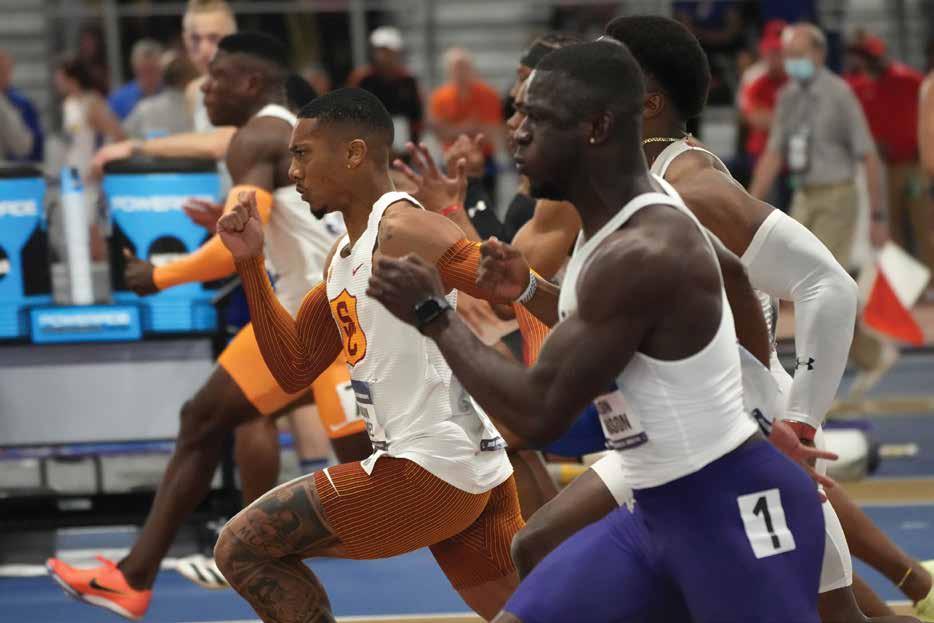
The Support Phase: The support phase begins as the ball of the foot makes contact with the ground. The center of mass is slightly behind the base of support. The support phase concludes when the center of mass is above the base of support, with the foot being flat on the ground. The quicker the sprinter completes this phase, the more efficient is the force application and the shorter the ground contact time. The better sprinters are favoring a decrease in ground time over an increase in leg range of motion. They are minimizing the horizontal touchdown distance in an effort to minimize ground time and maximize stride rate. Sprinters minimize ground time in two ways: (1) Properly preparing the leg for ground touchdown, and (2) Developing leg strength to generate the necessary velocity changes during a shorter ground time. A big problem in sprinting is stopping the downward fall of the body and producing upward projection into the next flight phase. This is achieved by producing large vertical forces during ground contact. This combination of force and time is impulse. Elite sprinters produce a greater force in a shorter time than average sprinters. This decreases ground time, increasing stride frequency, without affecting stride length, by producing greater force through greater leg strength.
As the foot strikes the ground, the ankle, knee, hip and shoulder joints must make a vertical line with each joint slightly forward
up through the shoulder. Learning the correct posture and kinesthetic feel of running takes years of concentrated effort.
Shoulder • Hip • Knee • Ankle •
To minimize touchdown distance and get the most out of this action, the sprinter should be very strong in the hamstring and glute muscles, since these pull the center of mass over the touchdown point during initial ground contact. The strength of these muscles dictates the success of the sprinter more than any other factor. The majority of force application occurs during this phase. To sprint mechanically correct, the foot touchdown slightly in front of the center of mass, increasing stride length, and providing a greater range of motion to produce the necessary vertical speed and maintain the horizontal motion on the ground.
The farther out in front of the center of mass the foot lands, the greater the range of motion on the leg, but the greater the ground contact time. A tradeoff occurs since sufficient range of motion is needed to produce the necessary ground forces and produce acceptable stride length, while ground time must be minimized to maximize stride frequency.
The majority of sprinting problems are caused by poor coaching cues. The cue to “run on the toes” causes the calf muscle to relax and the foot strikes the ground too far in front of the center of mass. The ankle and knee joints create a vertical line, but the hip joint is behind the knee joint, and the shoulder joint is forward of the hip joint creating the shape below. The sprinter is shorter than they stand in this position. This is a position that causes most injuries.
Shoulder • Hip • Knee • Ankle • Another poor cue coaches use is to “lengthen the stride.” This causes the athlete to strike more flat-footed, and in the same position as figure 2. The brain thinks in pictures, not words. As we cue the athlete, their brain creates that picture and attempts to perform the task. If an athlete is over-striding and we say, “don’t over-
22 techniques FEBRUARY 2023
BODY AND BALANCE
KIRBY LEE IMAGE OF SPORT

BODY AND
BALANCE
stride,” the brain does not have a picture for the word “don’t,” therefore, the athlete will continue to over-stride. The cue must be “shorten the stride,” a cue the brain can picture. The brain must have a very specific, clear picture from a coaching cue.
The Drive Phase: This phase begins when the center of mass is above the base of support and ends when the foot breaks contact with the ground. This phase allows the glutes to continue extension of the thigh and the quads become a contributor to force application. At the completion of the drive phase, the center of mass is projected on a parabolic curve. The center of mass has specific horizontal and vertical velocity. If the drive phase is overemphasized, there will be a poor recovery of the leg in the recovery phase. The key to sprinting is the ability to apply force in a relaxed manner. Major problems occur when tension is present in a sprinter. There is interference in the neuromuscular system, inhibiting the firing order of the muscle, the myotatic reflex mechanism is diminished and the timing of force application and retrieval are hindered. The sprinter must learn to let speed out, and not try to squeeze it out.
As the sprinter breaks contact with the track, the center of mass is projected along a parabolic curve. The length and the depth of this curve is greatly affected by the arms. Correct arm action is going to make this flight path longer with less depth. Incorrect arm action (the arms staying above the center of mass) will cause the flight path to be shorter and have greater depth. If the objective is to create maximum speed, correct arm action must be coached and perfected. Again, the hand must pass through the hip joint, and it must stay down in the back; any vertical movement in the posterior side of the body is going to move the chest down and the center of mass back.
If the coach has the sprinter stationary and perform the correct arm action, they will feel it in their feet. Their feet will feel like they must be ‘nailed’ to the ground to keep from moving. When doing the same movement with the arms above the center of mass, they will get the same feeling in the feet but there will be more rotation in the hips. Sprinting is a linear activity, not rotary.
Proper arm action must be coached and perfected to maximize speed. Having a sprinter practice proper arm technique while stationary, focusing on the center of mass, will allow them to feel and understand the advantage to correct arm action. If the coach does not emphasize correct technique, neither will the sprinter. It has to be a focal point in training.
The neuromuscular system is the dominant performance organ of the sprinter. Of the bio-motor abilities, coordination is probably the most neglected because it is difficult to measure. In sprint technique, it becomes critical in maximizing speed. The arms and legs must coordinate to create maximum stride length and stride frequency. Speed is limited by the sprinter’s technique. Sprinters cannot run faster than their technique will allow. Repetition of mistakes means perfection of errors.

24 techniques FEBRUARY 2023
STEVE THOMAS HAS COACHED NUMEROUS ALL-AMERICANS. HE’S TUTORED ONE TO A NATIONAL CHAMPIONSHIP. HE’S HAD A HAND IN THE CAREERS OF FIVE DIFFERENT OLYMPIANS, INCLUDING FORMER MISSISSIPPI STATE BULLDOG FALILATU OGUNKOYA, WHO WON SILVER AND BRONZE MEDALS AT THE 1996 GAMES IN ATLANTA.

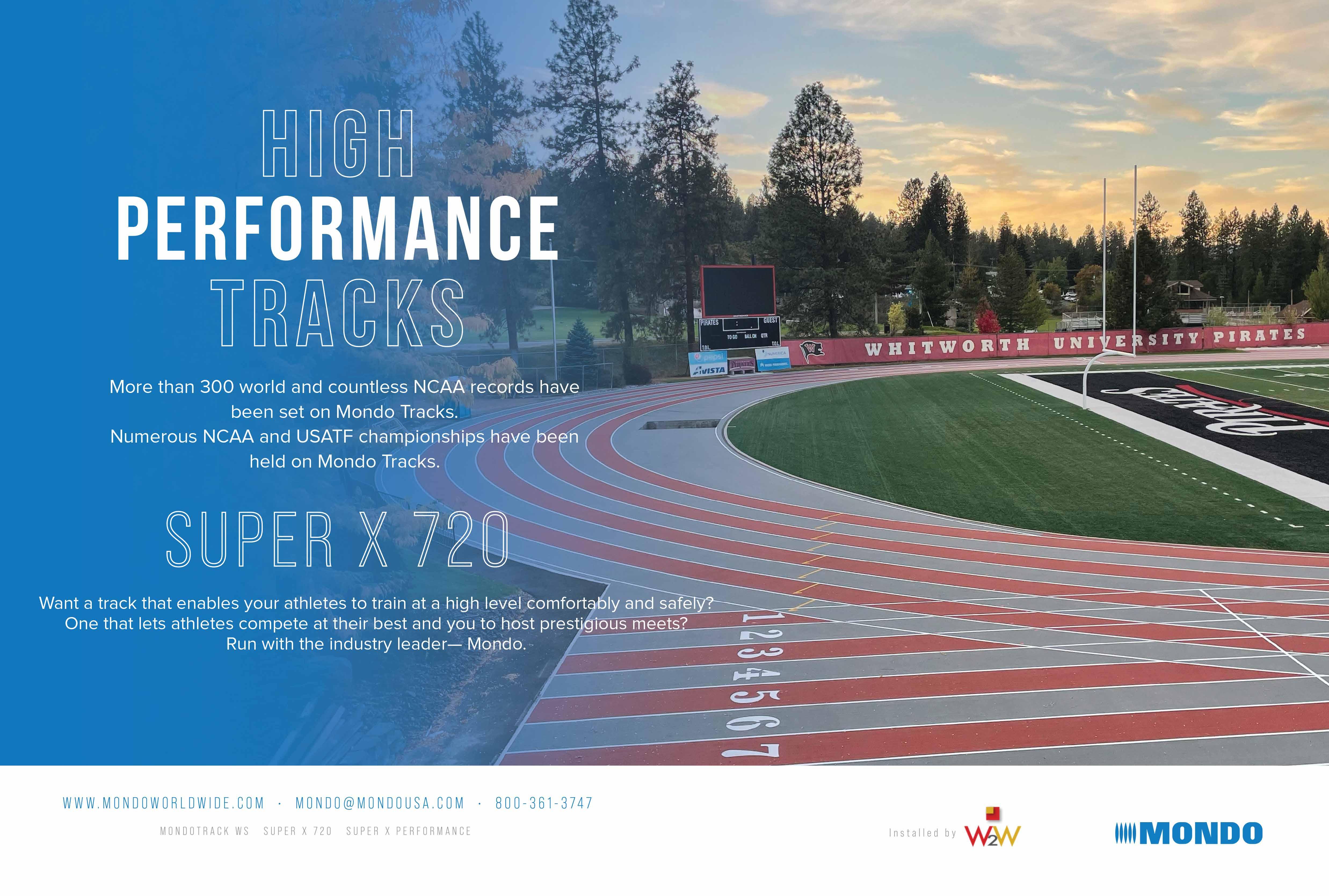


KIRBY LEE IMAGE OF SPORT 28 techniques FEBRUARY 2023
Running Periodization
Adapted from Running Periodization: Training
Theories to Run Faster
PART 2: REVERSE LINEAR PERIODIZATION
”
Historically, linear periodization was designed to improve strength, speed, and power, and so the training progressed from general conditioning (volume) to specific skills (intensity), with the highest intensity coming at the end of the training program.
Reverse linear periodization takes the opposite approach of linear periodization— a gradual and progressive increase in volume and decrease in intensity.
Most of the research comparing models of periodization has been done on strength training, with only one study comparing reverse linear periodization to the more traditional linear periodization on the development of muscular strength, which found that linear periodization is more effective than reverse linear periodization. Seems that if your athletes want to build bigger muscles and get stronger, linear periodization is the way to go.
But wait a minute! What if the specific
skill your athletes are most interested in mastering is endurance? Is linear periodization the most effective way to train to improve endurance? Scientists at Arizona State University wanted to find out. They divided 60 male and female college students into three groups of 20 (10 males and 10 females) that trained on a leg extension machine twice per week for 15 weeks: (1) a linear periodization group, which did 3 sets of 25-rep max (the maximum weight that can be lifted 25 times) for the first five weeks, 3 sets of 20-rep max for the next five weeks, and 3 sets of 15-rep max for the final five weeks; (2) a reverse linear periodization group, which trained with the opposite pattern—3 sets of 15-rep max for the first five weeks, 3 sets of 20-rep max for the next five weeks, and 3 sets of 25-rep max for the final five weeks; and (3) an undulating periodization group, which alternated the three workouts—3 sets of 25-rep max, 3 sets of 20-rep max, 3 sets of 15-rep max—every
training day throughout the 15 weeks. Following the training, the linear periodization group increased muscular endurance by 56 percent, the undulating periodization group increased by 55 percent, and the reverse linear periodization group increased by 73 percent. When it came to muscular strength, however, reverse linear periodization fared the worst, with a 5.6 percent increase, compared to 9.1 percent for linear periodization and 9.8 percent for undulating periodization. The scientists concluded, “It is apparent that gradual increases in volume (in a reverse linear fashion) are more effective at eliciting endurance gains than increases in intensity.” As the scientists pointed out, this could be a result of reverse linear periodization using a greater volume than linear or undulating periodization immediately before the test of muscular endurance. Of note is that when strength was the fitness factor being tested rather than endurance, reverse linear periodiza-
FEBRUARY 2023 techniques 29
“
“FOR LONG RACES, IT MAY BE BETTER TO TRAIN SPEED FIRST, AND THEN TRAIN THE ENDURANCE TO SUSTAIN A HIGH FRACTION OF THAT SPEED.”
RUNNING PERIODIZATION
tion was not as effective as linear periodization, which increases intensity closer to the test of muscular strength. Thus, linear and undulating periodization are more effective than reverse linear periodization for increasing muscle strength, while reverse linear periodization is more effective for increasing muscle endurance.
When it comes to aerobic endurance performance, there is a lack of scientific evidence on the efficacy of one periodization model over another. Only a few studies have examined the effects of reverse linear periodization on either the physiological factors of running or on actual race (or time trial) performance, with results showing a slight or no superiority of reverse linear periodization.
In one of those studies, 30 male and female recreational runners were randomly assigned to one of three groups that did interval training for 12 weeks: (1) a linear periodization group, which began the training program with longer interval workouts at a lower intensity and progressed to shorter workouts at a higher intensity, (2) a reverse linear periodization group, which began the training program with shorter interval workouts at a higher intensity and progressed to longer workouts at a lower intensity, and (3) a control group, which continued with its own independent training. Workout paces for the linear and reverse linear periodization groups were based on a 5K time trial at the beginning of the study. After 12 weeks of training, the linear periodization group improved its 5K time trial by an average of 5.5 percent (1 minute, 17 seconds), the reverse linear periodization group improved by 8.1 percent (1 minute, 53 seconds), and the control group improved by 0.1 percent (4 seconds). Both periodization groups had a significantly greater improvement than did the control group, but despite the greater improvement in the reverse linear periodization group, there was no statistical difference between the periodization groups. All three groups slightly improved VO2max, speed at lactate threshold, and running economy, although there were no differences between groups.
Despite no superiority of one type of periodization over the other in regard to physiological factors, and a small practical superiority of the reverse linear periodization on 5K time trial performance, an interesting finding of this study is that the reverse linear periodization group felt that the longer interval workouts (which came later in the
training program for reverse linear periodization and earlier for linear periodization) were less demanding than the linear periodization group. This suggests that doing faster (anaerobic) workouts first can make the later, more metabolically stressful (VO2max) workouts seem easier.
In another study at University of Agder in Norway, three different periodization models of interval training were compared for 12 weeks. Sixty-three cyclists were divided into three groups matched for age, cycling experience, body mass, and physiological factors (VO2max, power output at lactate threshold, peak power output, and average power output during an all-out 40-minute time trial): (1) linear periodization, (2) reverse linear periodization, and (3) undulating periodization. Each group did eight interval workouts in each of three four-week mesocycles. The linear periodization group increased intensity over the 12 weeks, with eight workouts of 4 x 16 minutes in weeks 1 to 4, eight workouts of 4 x 8 minutes in weeks 5 to 8, and eight workouts of 4 x 4 minutes in weeks 9 to 12; the reverse linear periodization group did the opposite pattern, with eight workouts of 4 x 4 minutes in weeks 1 to 4, eight workouts of 4 x 8 minutes in weeks 5 to 8, and eight workouts of 4 x 16 minutes in weeks 9 to 12; and the undulating periodization group mixed the intensity over the 12 weeks, alternating workouts of 4 x 16 minutes, 4 x 8 minutes, and 4 x 4 minutes in each four-week mesocycle. All workouts were done with two minutes of recovery between reps. All cyclists completed 24 interval workouts in 12 weeks.
On non-interval workout days, the cyclists did as much low-intensity training as they wanted. For six weeks prior to the 12-week training intervention, the cyclists did as much low-intensity training as they wanted and did one interval workout each week.
After 12 weeks, all three groups significantly increased power output at lactate threshold (by 3 to 6 percent) and both 40-minute time trial power output and peak power output (by 5 to 8 percent), although the specific organization of the interval training (linear, reverse linear, undulating) didn’t seem to matter, as there were no differences between groups. On an individual basis, however, more people fared better with the linear periodization approach: 87 percent of participants in the linear periodization group improved 40-minute time trial power output by more than 3 percent, compared to 63 percent of participants in
the reverse linear periodization group and 56 percent of participants in the undulating periodization group.
The few other studies that have compared reverse linear periodization to another periodization model have also not shown that reverse linear periodization is a better training method, in part because the studies did not match the participants on physiological variables or time trial performance when separating them into groups, nor did they equate the overall training load between training groups, which makes it difficult to assess the efficacy of one periodization model over another.
While the small amount of research on the subject doesn’t support that reverse linear periodization is better than linear periodization (except in the case of strength training for muscular endurance), it doesn’t support that it is worse. Reverse linear periodization may be most effective for long-distance races, like half-marathon and marathon, for a few reasons.
Firstly, since the half-marathon and marathon depend so heavily on aerobic endurance, a training program that increases volume and focuses more on endurance as runners get closer to the race is more likely to produce better results. Long runs, acidosis threshold runs, and higher overall mileage is more half-marathon- and marathonspecific than are VO2max interval workouts. If runners use a linear periodized approach for the half-marathon and marathon, that would mean they’re reducing the volume while increasing the intensity as they get closer to the race. If they take a reverse linear periodized approach, by starting with higher intensity and decreasing the intensity over time as they increase the volume, they’re doing more race-specific work as they get closer to the race.
Secondly, for long races, it may be better to train speed first, and then train the endurance to sustain a high fraction of that speed, especially if runners are not already fast for shorter races.
For example, say a runner has run 3:15 for a marathon (7:26 per mile pace) and her goal is to run under 3 hours (6:52 per mile pace). Her one-mile PR is 6:20, which means she ran the marathon one minute and six seconds per mile (or 17.4 percent) slower than her one-mile time (which is very good). However, with a one-mile PR of 6:20, she won’t be able to run 6:52 pace for 3 hours; that’s a difference in pace of only 32 seconds (or 8.4 percent slower) per mile.
30 techniques FEBRUARY 2023
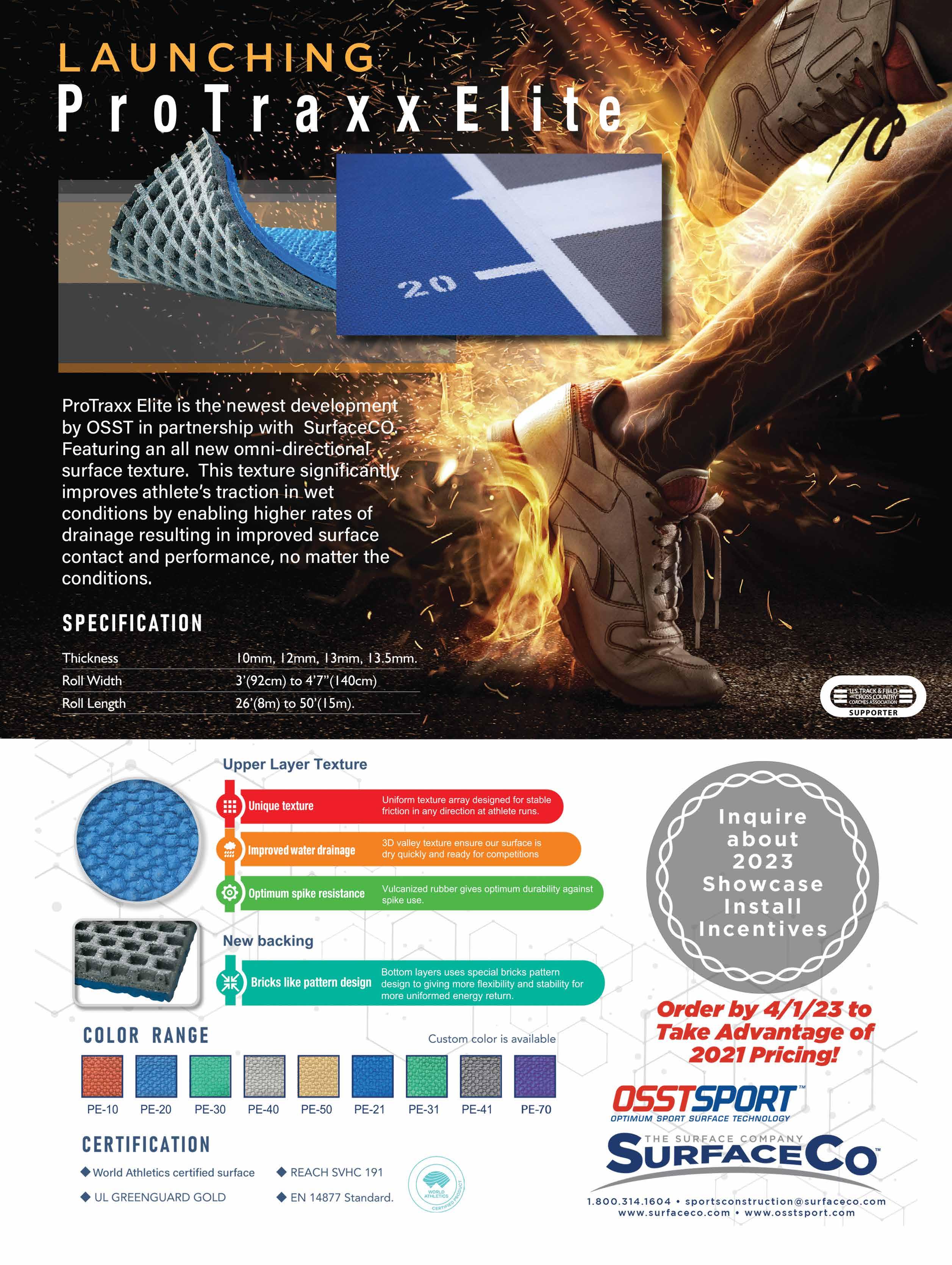
Even if her mile PR is 6:00, she still won’t be able to run a marathon in under 3 hours.
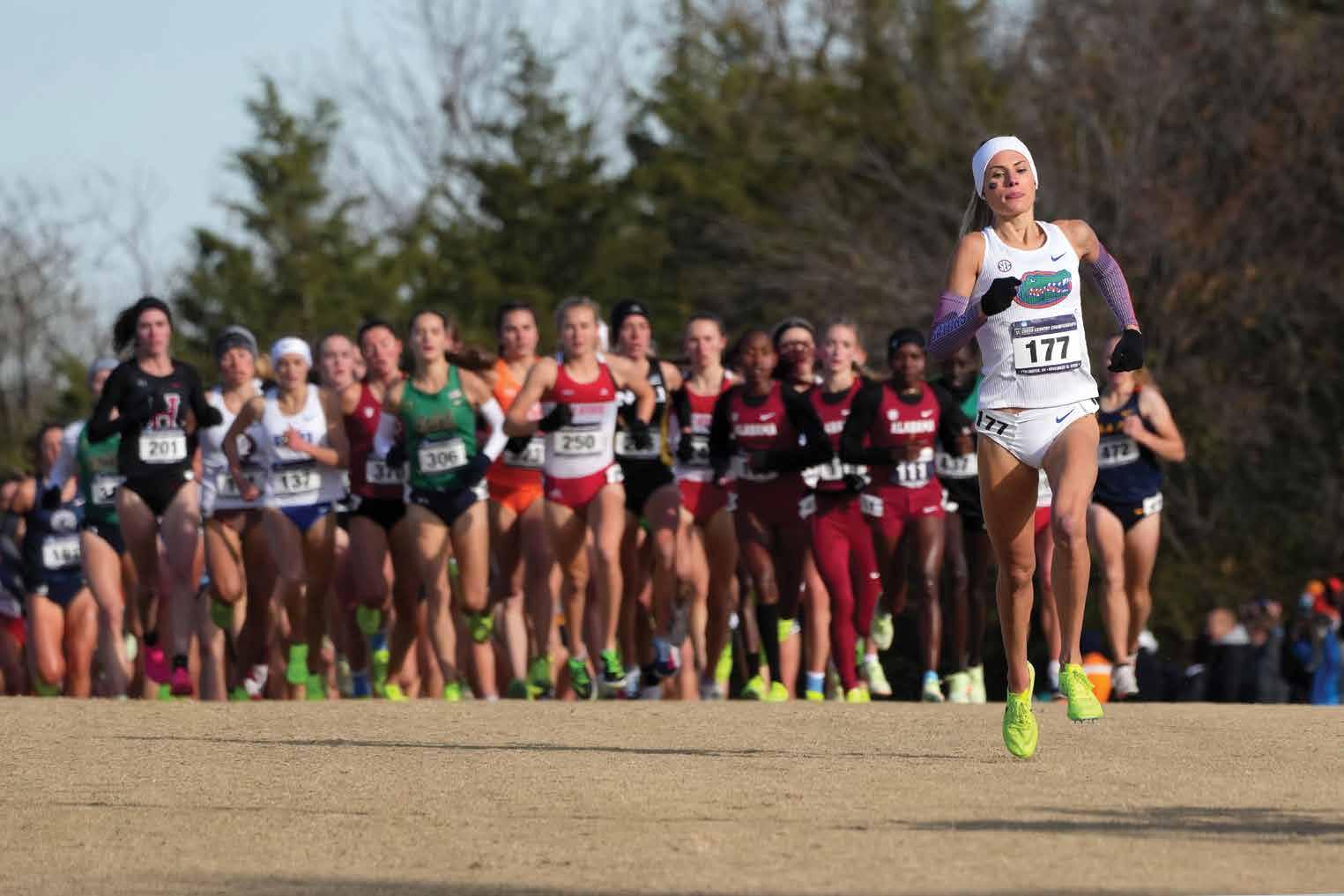
To run a sub 3-hour marathon, she can continue to drive the endurance nail into the wall with greater and greater amounts of mileage, long runs, and quality endurance workouts to narrow the difference between her marathon pace and her one-mile PR, or she can get take a reverse linear periodization approach, first working on her basic speed to run one mile faster, and then training her ability to hold the same pace difference between her mile and marathon as she did before. If she can get her one-mile time down to 5:46, then 6:52 pace is the same pace difference (1:06 per mile; 19.1 percent slower) as when she ran 3:15.
This is not an unimportant point. Many runners want to run a faster half-marathon or marathon, but they don’t have the speed reserve to do so. They also lack experience with faster running, instead getting caught up in the long-run, slow-mileage-building approach to marathon training. Many rec-
reational runners, even those who are good, would be well served by developing their speed before focusing their attention on the marathon. (It’s not a coincidence that most elite marathon runners moved up to the marathon after having success at shorter distances. Very few elite marathoners began their running careers with the marathon, and practically no one has moved down to the marathon from ultramarathons, or from the marathon down to shorter races.)
The physiological corollary for taking a reverse linear periodization approach for long races considers that VO2max, as the ultimate ruler of performance, should be improved first, before focusing on improving the fraction of VO2max that can be sustained, a factor that is reflected by the acidosis threshold, as well as other metabolic factors. (VO2max is the major factor for running performance and explains much of the difference in performance between runners, even between those who are elite and subelite. Only in a group of homogeneous run-
ners with similar VO2max values is VO2max not a good predictor of performance.)
Thirdly, the early introduction of highintensity training can improve the skill of running, which is especially important for less-skilled runners. Most people who run just walk out the door and start running. They concern themselves with trainingrelated variables, such as weekly mileage, length of long runs, pace per mile, and heart rate, and sometimes give even more concern to the proper angle and lighting of their post-run Instagram photo. They pay little or no attention to how they run. Developing the skill of running is the first (and often neglected) step in becoming a better runner or preparing for a race. Running fast trains the skill of running. It has a way of “cleaning up” biomechanical flaws and improving neuromuscular coordination (the way the central nervous system “communicates” with the muscles), leading to better running mechanics, including a shortened ground contact time and improvement in the mus-
32 techniques FEBRUARY 2023
RUNNING PERIODIZATION KIRBY LEE IMAGE OF SPORT
cles’ ability to produce force against the ground. With better skill, runners are better able to handle and thrive off their training.
In summary, reverse linear periodization is an effective training method in a few instances—when training for longer races, to create a speed reserve in runners who don’t have good speed and who don’t have a history of speed work, and to practice the skill of running, which is especially important for beginner runners.
Part 3 of this series on periodization will discuss block periodization and undulating periodization.

REFERENCES
Prestes, J., De Lima, C., Frollini, A.B., Donatto, F.F., and Conte, M. Comparison of linear and reverse linear periodization effects on maximal strength and body composition. Journal of Strength and Conditioning Research, 23(1):266-274, 2009.
Rhea, M.R., Phillips, W.T., Burkett, L.N., Stone, W.J., Ball, S.D., Alvar, B.A., and Thomas, A.B. A comparison of linear and daily undulating periodized programs with equated volume and intensity for local mus-
cular endurance. Journal of Strength and Conditioning Research, 17(1):82-87, 2003.
Bradbury, D.G., Landers, G.J., Benjanuvatra, N., and Goods, P.S. Comparison of linear and reverse linear periodized programs with equated volume and intensity for endurance running performance. Journal of Strength and Conditioning Research, 34(5):1345-1353, 2020.
Arroyo-Toledo, J.J., Cantos-Polo, I., Liedtke, J., and Palomo-Vélez, J.C. Concentrated load on a reverse periodization, propel higher positives effects on track test performance, than traditional sequence. Imperial Journal of Interdisciplinary Research, 3(2):470-476, 2017.
Gómez Martín, J.P., Clemente-Suárez, V.J., and Ramos-Campo, D.J. Hematological and running performance modification of trained athletes after reverse vs. block training periodization. International Journal of Environmental Research and Public Health, 17(13):4825, 2020.
Clemente-Suárez, V.J. and RamosCampo, D.J. Effectiveness of reverse vs. traditional linear training periodization in triathlon. International Journal of
Environmental Research and Public Health, 16(15):2807, 2019.
Sylta, Ø., Tønnessen, E., Hammarström, D., Danielsen, J., Skovereng, K., Ravn, T., Rønnestad, B.R., Sandbakk, Ø., and Seiler, S. The effect of different high-intensity periodization models on endurance adaptations. Medicine and Science in Sports and Exercise, 48(11):2165-2174, 2016.
Billat, V. Current perspectives on performance improvement in the marathon: From universalisation to training optimisation. New Studies in Athletics, 20(3):21-39, 2005.
DR. JASON KARP IS A COACH, EXERCISE PHYSIOLOGIST, BESTSELLING AUTHOR OF 13 BOOKS AND MORE THAN 400 ARTICLES, AND TED SPEAKER. HE IS THE 2011 IDEA PERSONAL TRAINER OF THE YEAR AND TWO-TIME RECIPIENT OF THE PRESIDENT’S COUNCIL ON SPORTS, FITNESS & NUTRITION COMMUNITY LEADERSHIP AWARD. HIS REVO₂LUTION RUNNING COACHING CERTIFICATION, WHICH HAS BEEN OBTAINED BY COACHES AND FITNESS PROFESSIONALS IN 26 COUNTRIES, WAS ACQUIRED BY INTERNATIONAL SPORTS SCIENCES ASSOCIATION IN 2022. IN 2021, HE BECAME THE FIRST AMERICAN DISTANCE RUNNING COACH TO LIVE AND COACH IN KENYA. RUNNING PERIODIZATION AND HIS OTHER BOOKS ARE AVAILABLE ON AMAZON.
FEBRUARY 2023 techniques 33

Breaking Barriers
The mysterious alchemy of improvement
Part one of this series presented a statistical model of improvement rates three NCAA distance events, the 1500m, 5000m and 10,000m. To summarize it briefly: for most athletes, the faster one gets, the harder it is to keep getting faster.
Part two takes a closer look at the athletes who were most successful in bucking that trend – the most improved runners (relative to expectation) in the classes of 2021 and 2022: Beginning with Limits
Any discussion of improvement should start with an acknowledgment of certain limits – in particular, the limited benefit of any given training stimulus. No matter how successful the initial results, doing the same thing – or even more of the same thing – over an extended period of time will
result in a diminishing return. And past a certain point, the risks of increasing mileage or intensity outweigh the potential benefits. Most high-level athletes in the NCAA train very hard, but there is an upper limit to how much more an athlete can run. As we will see, athletes often find greater success by reining in the impulse to do more. Certainly, effective training is one of the keys to improvement, but training isn’t the whole answer; indeed, it is notable how few athletes or coaches emphasized training as a significant difference-maker – certainly all the athletes among the most improved train hard, but so do most of their peers.
We must also recognize the limited validity of drawing general conclusions from the stories of a small number of athletes. The more we veer into the anecdotal, the more
caution we must exercise. However, to the extent that we can learn from what worked for these athletes, we can help our athletes become stronger, faster, more consistent, and even happier. So while the particulars of what worked vary from athlete to athlete, there do appear to be some commonalties: first, progress comes from change, and second, positive change is the result of a process of rigorous self-examination. For coaches, the challenge is in understanding how to facilitate this process.
THE DANGEROUS INTOXICATION OF MORE Running is a sport that rewards hard work. Often for runners, the desire to do more is their default mentality: if some hard training is good, more must be better. Doing more becomes a security blanket, and coming
FEBRUARY 2023 techniques 35
10,000m
5000m 1500m
Edwin Kurgat
Iowa State (2018-2021) Tennessee-Martin (2017)

Florida State (2021) Southern Utah (2016-19)
to terms with the limits of training harder means facing a runner’s greatest fear: not doing enough. Adriaan Wildschutt said his approach to training had always been, “the harder I push, the better I get.” Whatever the maximum option was – for miles or intervals – he was going to do it. Only as his faith in his own ability grew, and he gained trust in his training, was he able to moderate this approach.
Kasey Knevelbaard began his career at
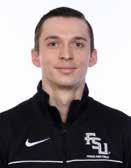


Southern Utah, on a team, he said, that prided itself on a tough, blue-collar mentality. “We all thought we were better than we were at the time, and we had very competitive mindset – you’re young, you’re stupid, you just go for it,” he said. “I wanted to be the next Cam Levins.” But his body didn’t respond to mileage the way Levins had. Though it was a difficult mental change to make, he let his teammates pile up the big mileage, while he worked on just staying

healthy and improving his speed.
Edwin Kurgat, who transferred to Iowa State from the University of TennesseeMartin, had arrived in Tennessee from Kenya with a very limited training base – in high school, he had been a field hockey player. While he had great success at Tennessee-Martin, he also had a hard time saying no: “Everytime somebody wanted to go for a run, I was like, ‘sure!’” He found himself battling chronic lower leg inju-

36 techniques FEBRUARY 2023 BREAKING BARRIERS
Lexie Thompson Weber State
Eric Hamer Colorado State
Elly Henes North Carolina State
Anna Camp-Bennett BYU
THE MOST IMPROVED ATHLETES OF 2021
Kasey Knevelbaard

FEBRUARY 2023 techniques 37
10,000m
Erika Freyhof Nebraska
5000m
(tie)
Emmanuel Cheboson Arkansas (2021-22)



Louisville (2018-19)
Abby Nichols


Colorado (2021-22)
Ohio State (2016-19)
Adriaan Wildschutt
Florida State (2021-22)
Coastal Carolina (2018-19)
1500m
(tie)
Aaron Bienenfeld Oregon (2022) Cinncinnati (2018-21)


38 techniques FEBRUARY 2023 BREAKING BARRIERS
Emily Mackay Binghamton
THE MOST IMPROVED ATHLETES OF 2022
Yared Nuguse Notre Dame

FEBRUARY 2023 techniques 39
ries. At Iowa State, he and coach Jeremy Sudbury agreed on a very slow start – no more than 65 miles per week, nothing faster than 5:00 miles. They found the sweet spot for mileage was typically a maximum in the 80s – and that was the max. Kurgat had to learn to accept doing less when it was needed – for example, when his academic work was such that he was too exhausted to keep his mileage up. Sudbury trusted Kurgat’s commitment to both running and school; he had to help Kurgat learn to trust himself and what his body was telling him. Just as crucially, he had to emphasize the importance of open communication – like many athletes, Kurgat’s instinct was to insist he was fine, even when he needed rest.
Of course, there are times when athletes do benefit from more. When Abby Nichols transferred to CU from Ohio State, she found herself benefitting from doing “more volume, faster.” CU’s coach, Mark Wetmore, stresses the need to find the “safe and productive level of training for each individual” to ensure consistent, uninterrupted training – while also creating the greatest possible stimulus and adaptation. With Nichols, he said, “we had to be patient. She arrived not yet ready to step into the training of the best athletes.”
Before simply jumping into heavier training, athletes must ask what they need to do in order to handle more; the so-called “little things” turn out to be pretty big. To help adapt to the training, Nichols started working with a nutritionist: “it was eye-opening,” she said. “I thought I knew what I was doing.” Nebraska’s Erika Freyhof focused on sleep: a serious student, she nonetheless stopped school work at 8 p.m. every night. And Colorado State’s Eric Hamer developed a mantra to remind himself to do the little things: “You’re not talented enough to be stupid.”
Elly Henes said that at the end of her freshman year, “I was toast… I could hardly finish a run.” To handle the training over the long grind of the school year, she too had to work on the little things, but found she couldn’t work on them all at once. She added one point of focus each year, starting with eating and nutrition; then making sure she was consistent in taking iron supplements; then building strength; then using sports massage to recover.
WHEN GOOD ENOUGH ISN’T Training tweaks are relatively straightforward, but often the need for change is less apparent, and the fixes more difficult.
Weber State’s Lexie Thompson had already improved a remarkable amount by the end of her sophomore year, cutting over three minutes off her time in the 10,000m. But she still had to face the uncomfortable truth that, by her own standards, she was flailing. “I had great workouts,” she said, “but in races I would panic and start to fall apart.” She asked her coach, Paul Pilkington, for a redshirt year, and spent the entire year, she says, “figuring out the next steps.”
She began working with the school’s sports psychologist, who asked her to explain the difference between her great workouts and subpar races: “When I started to freak out in practice,” she said, “I could take a few deep breaths and talk myself through it – ‘OK, just a couple more intervals’ – and get back on track.” The psychologist asked what seems, with hindsight, an obvious question: “Why don’t you do that in meets?” The fix, though obvious – use the same technique in meets – wasn’t simple, and is ongoing: the process of mastering negative reactions requires consistent, intentional focus, and Thompson spent her next two years continuously working on it.
Henes too, had to face the reality that despite what appeared from the outside to be a fairly successful career, she wasn’t where she wanted to be. “Freshman year,” she said, “my only goal was to win a national title – I told myself this is the only thing I’ll be happy with.” Junior year, she got lapped in both her events at the indoor NCAA meet. Her ambition had become a burden. “I would see the clock, see [my goal] slipping away, I’d start to feel sorry for myself, my stride would tighten up – it wasn’t working.” She began working with a sports psychologist to help her turn away from outcome-oriented goals. Senior year, she achieved the goal she’d set as a freshman, but only by changing her focus. “By the time I got there [senior year], it was more, ‘this is my last race, and I just want to see how hard I can run, to leave it all out there.’”
When Anna Camp-Bennett entered her senior year, her coach, Diljeet Taylor believed she was capable of winning the NCAA title in the 1500m. Camp-Bennett had come a long way: her first season at BYU, she finished dead last in nearly every workout. Her improvement had been remarkable, but she still needed to work on not letting her fears impede her racing. For Taylor and Bennett, it was a long process – “lots of conversation,” said Taylor. Crucially, Camp-Bennett had to come to
terms with the fact that her fear wouldn’t just go away – that she had to acknowledge it as one of many emotions she’d have before big races. Before NCAA regionals, Taylor told her, “If you’re 10% more excited and grateful than you are scared, and have 10% more faith than you have fear, you’ll be OK.’”
FINDING DIRECTION
Sometimes, the necessary changes go deeper than just training or racing. Eric Hamer had a bumpy start to his career at Colorado State, and it took him a year and half to start to put things right. “Freshman and sophomore years, when something bad happened, I just accepted it, and wondered why a bad thing happened to a good guy,” he recalled. He wasn’t running well, and school wasn’t going well either. He nearly lost his scholarship. He began to ask himself questions that had little to do with running: “What kind of person do I want to be? How can I be held accountable? I had to look at all the things I’m not good at – and not be afraid of that.”
Emily Mackay had been a star in high school in New York, running 4:25 for 1500m as a junior. But iron deficiency followed by injury derailed her senior year, and continued to plague her during her first year at Oregon State. After two trimesters at OSU – and trying to come back from injury too quickly – she said, “I fizzled out.” Though she was supposed to be rehabbing, she could barely make herself cross-train. Mentally checked out of running, wanting to be closer to home, she returned to Binghamton for the spring trimester. She was basically starting from zero; coach Annette Acuff had her walk on to the team. Her first race, an indoor mile, was the most painful 5:20 of her life. “That was from hell,” she told Acuff. She was able to hang on to her belief in her talent, even though it wasn’t until 2019 that she finally approached her best high school times – four years later. The bigger issue was trying to figure out why she should bother. Mackay said her main goal was “to fall back in love with running.” The path back had little to do with how fast she raced. “I focused on physical and mental wellness,” she said, “on being intentional with my runs.”
EASIER SAID THAN DONE
If progress comes from change, and positive change is the result of rigorous self-examination, it is fair to ask how one develops the
40 techniques FEBRUARY 2023
BREAKING BARRIERS

capacity to ask hard questions of oneself – and to answer honestly. Coaches may be able to facilitate this process in two ways. First, practice it: help athletes respond properly when things don’t go well, and practice doing it when the stakes are lower. North Carolina State Coach Laurie Henes, both mother and coach of Elly, said that, while it is hard to do, she gives her athletes room to fail early on. “You don’t want them messing up in big ways, but they need to make some mistakes to learn.”
Obviously, facilitating failure isn’t a comprehensive coaching philosophy; it is only effective if athletes are also developing the confidence to bounce back from mistakes. BYU’s Coach Taylor says “You have to give [athletes] small wins and really celebrate those.” (Camp-Bennett, in turn, says “I still remember the first time she gave me a highfive – I remember thinking, ‘she noticed me!’” – which was enough to have her floating on a high for days.)
Second, help athletes find balance. Hamer’s coach at Colorado State, Art Siemers says, “You have to be happy in life before you can be happy and successful as a runner.” Nearly every athlete interviewed stressed the importance of balance, but there is no universal prescription for what it means to lead a balanced life. It may differ for each runner, but the important thing is having a strong sense of how running fits in one’s overall life. Once runners have a sense of that, asking hard questions about what’s not working in their running life can be less threatening.
For Nebraska’s Freyhof, balance meant “being you and doing what you enjoy,” having a community of people outside athletics – her church community was particularly important. Similarly, Camp-Bennett said that finding and recognizing happiness – “learning to take care of other things in life, like family and friends, my spiritual relationship” – remains an intentional goal. Hamer learned not to let his natural competitiveness interfere with making the kinds of connections that enrich an athlete’s experience in the sport – he said he had to remind himself that “other people’s success is not your failure; pursuing relationships within the sport doesn’t have to come at the cost of your career – in fact, it might make you better.”
For Nichols, balance was a process of becoming more committed to running, while keeping it in its place. Her first few years at Ohio State, she says she was “kind
of floating around.” She readily admitted that “freshman year, I was having a lot of fun socially.” Transferring to CU was about finding a direction she could believe in: “I would do everything the coaches told me to do, then I would leave practice and put it all behind me.” Because she had such trust in her coaches at CU, she discovered she could “just not be neurotic or anything; just move on from bad workouts.” Coach Wetmore said of Nichols, “She is a uniquely calm and happy individual… indisposed to drama. She shows up, takes the trouble to understand the tasks and goals of the assignment, then settles into the work.”
For Yared Nuguse, balance is about remembering why he runs. “Running is my stress reliever,” he said. “Running is supposed to be fun, and if it’s ever not, I’ll stop.” Like Nichols, he doesn’t dwell on practices. “I don’t like to place my selfworth in workouts too much.” Doesn’t matter if they’re good or bad; once they take on too much importance, they can become a source of stress. And if the race or the moment threatens to overwhelm him, he reminds himself: “Take a breath. Calm down. Just have fun – it’s me just racing a bunch of fast people; let’s see what happens.”
There is another sense in which balance is important: that of balancing the outcome-oriented pressure of the sport with the need to focus more on the process of getting oneself ready to achieve those outcomes. Hamer wanted to be all-American –but had to learn to set different goals: “stay healthy, get better at nutrition, learn to like running more,” he said. “When I did that, for once, I was not thinking about being allAmerican, but I had the tools to do it.” Elly Henes and Camp-Bennett were both able to manage the pressure of racing for a national title by focusing instead on the opportunity to simply run their best race.
It doesn’t always work out so well, despite the athlete’s best effortss. Knevelbaard admitted to having a hard time dealing with the pressure of his final year at Florida State, during which he was both aiming to win the NCAA title, and auditioning for a professional contract. “It’s stressful,” he said. “You sell yourself to agents and companies – I felt pressure, a need to run [a certain time] to get a contract. Not the best mindset.”
Wildschuut arrived at the NCAA XC championship in 2021 believing he could win, and trying to approach the way he
always did: “You gotta face reality – it’s going to hurt bad. I know, if I don’t win, he’s gonna hurt at the end.” Still, the pressure to win was such that one hour before the race, “I couldn’t even stand on my legs.” Nichols, whom Wetmore described as “very businesslike in her racing,” arrived at her last NCAA meet in rough shape. “I know when I’m too stressed out about the outcome, I race worse,” she said. “But I couldn’t really let go of that at NCAAs… I had a wimpy breakfast, terrible sleep two weeks leading up to it. I should’ve talked to more people about it… I treated nationals differently from other races.”
The process of improvement is ongoing. Whether they ended their careers with a dream race, like Henes or Camp-Bennett, or ended with a race they felt didn’t match their potential, like Knevelbaard or Nichols, their final reflections on their NCAA careers will inform how they approach what lies ahead. More importantly, their final lesson may simply be that improvement is not linear or automatic. “The sport is not as input – output as you want it to be,” says Knevelbaard. “It’s not a sport that owes you anything. But be patient – things will come.”
42 techniques FEBRUARY 2023
BREAKING BARRIERS
STEPHEN LANE TEACHES ECONOMICS AND HISTORY AT CONCORD-CARLISLE HIGH SCHOOL IN CONCORD, MASSACHUSETTS. HE COACHED TRACK AND FIELD FOR OVER 20 YEARS, AND IS THE MEET DIRECTOR FOR THE ADRIAN MARTINEZ CLASSIC. HIS BOOK, RACE OF THE GODS, A HISTORY OF THE FIRST WOMEN’S OLYMPIC MARATHON, WILL BE PUBLISHED BY LYONS PRESS IN THE FALL OF 2023. HE WISHES TO THANK PHIL BROWN FOR HIS HELP WITH THE STATISTICAL ANALYSIS - AND TO NOTE THAT WHATEVER ERRORS REMAIN ARE SOLELY THE AUTHOR’S.
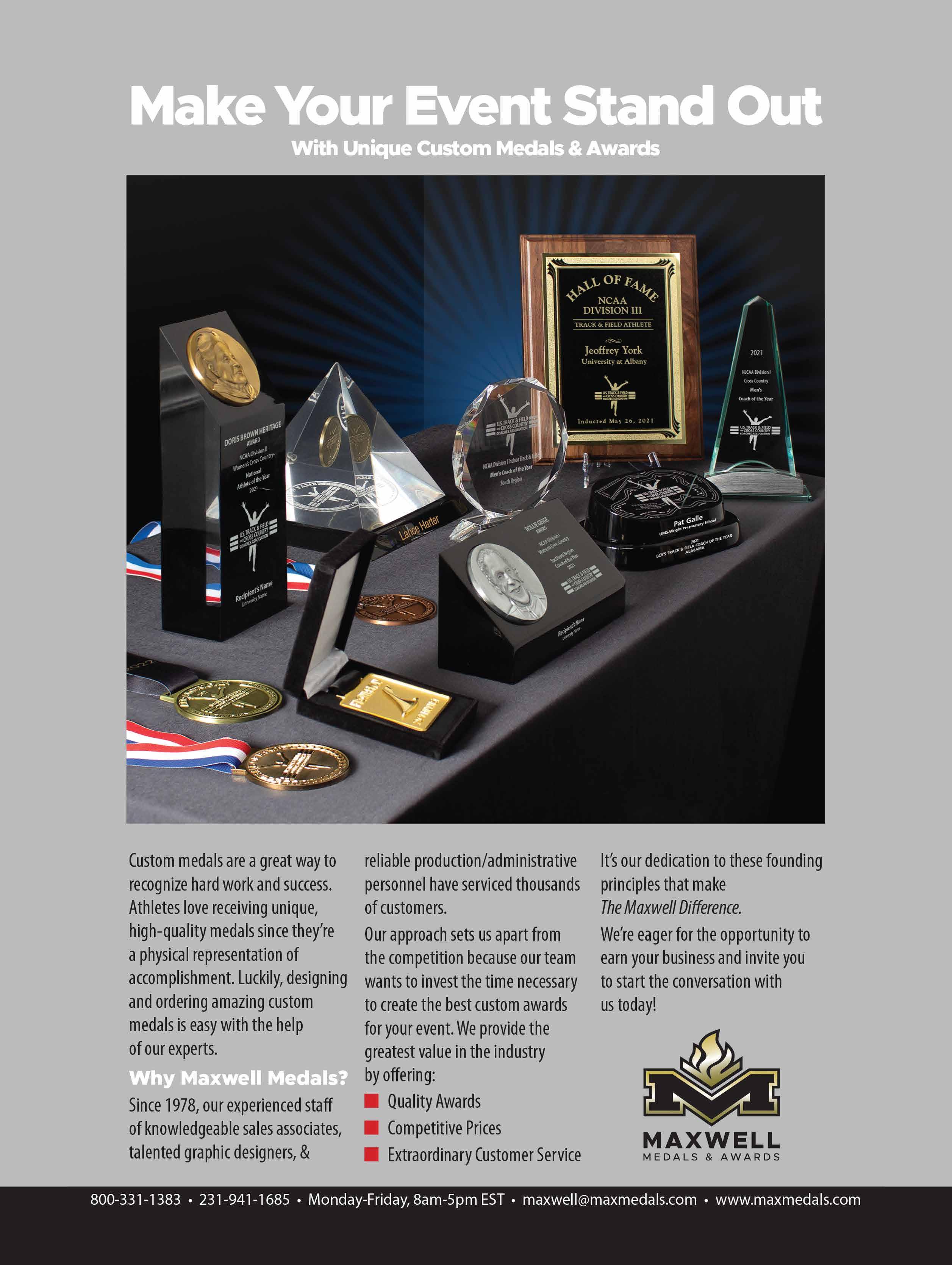






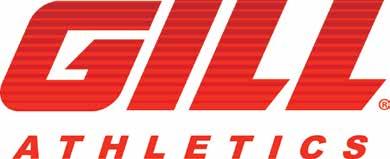


44 techniques FEBRUARY 2023 gillporter.com ucsspirit.com sportsbyapt.com/sport/track directathletics.com USTFCCCA Supporters mondoworldwide.com geosurfaces.com mfathletic.com vsathletics.com ucsspirit.com boosttreadmills.com
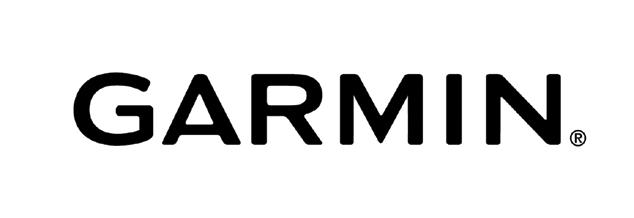



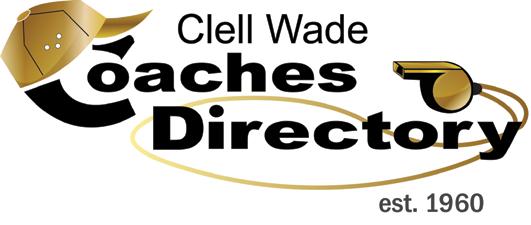







FEBRUARY 2023 techniques 45 garmin.com beynonsports.com getonform.com balfour.com connect.marines.com sportlinesevices.com Through their ongoing support of the U.S. Track & Field and Cross Country Coaches Association, these companies demonstrate their strong commitment to the sports of Track & Field and Cross Country. The USTFCCCA strongly encourages each member to purchase products and services from these supporters. coachesdirectory.com maxmedals.com surfaceco.com elliptigo.com lightspeedlift.com smartracks.run
2022 CROSS COUNTRY NATIONAL COACHES AND ATHLETES OF THE YEAR


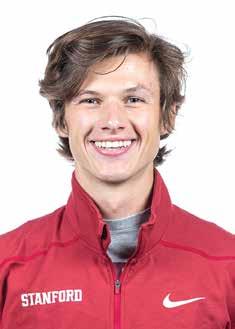
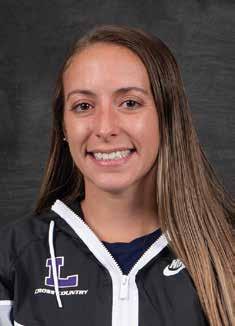

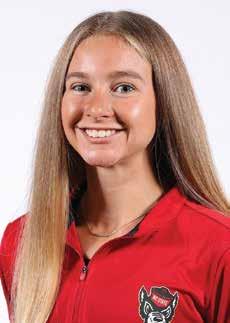

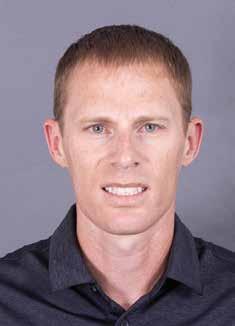


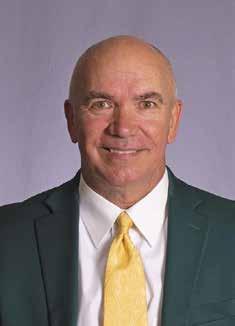

46 techniques FEBRUARY 2023
Laurie Henes NC State Women’s COY
Damon Martin Adams State Women’s COY
Bobby Van Allen Johns Hopkins Women’s COY
Michael Smith Northern Arizona Men’s COY
Chris Siemers Colorado School of Mines Men’s COY
Riley Macon MIT Men’s COY
Katelyn Tuohy NC State Women’s AOY
Stephanie Cotter Adams State Women’s AOY
Kassie Parker Loras Women’s AOY
Charles Hicks Stanford Men’s AOY
Dillon Powell Colorado School of Mines Men’s AOY
Alex Phillip John Carroll Men’s AOY
NCAA DIVISION I
NCAA DIVISION II
NCAA DIVISION III


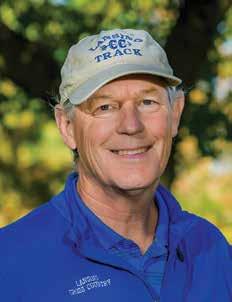






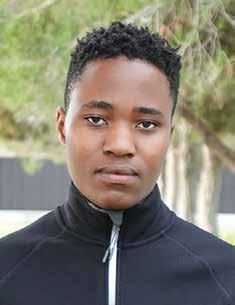




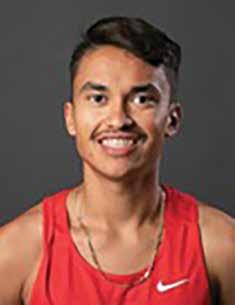

FEBRUARY 2023 techniques 47
Quinn White Taylor (Ind.) Women’s COY
Janae Richardson Southern Idaho Women’s COY
Jim Robinson Lansing (Mich.) CC Women’s COY
Jim Macnider Harper (Ill.) Women’s COY
Nate Wolf Dordt (Iowa) Men’s COY
Brady Johnson Colby (Kan.) CC Men’s COY
David Barney Paradise Valley (Ariz.) CC Men’s COY
Robert Cervenka DuPage (Ill.) Men’s COY
Lina May William Carey (Miss.) Women’s AOY
Faith Nyathi El Paso (Texas) CC Women’s AOY
Hayley Burns Coconino (Ariz.) CC Women’s AOY
Lydia Smith SUNY Erie Women’s AOY
Abraham Chelangam Oklahoma City Men’s AOY
Sanele Masondo Colby (Kan.) CC Men’s AOY
Youtel Garcia Mesa (Ariz.) CC Men’s AOY
NAIA NJCAA DIVISION I NJCAA DIVISION III NJCAA DIVISION II
Nicholas Keeling College of DuPage (Ill.) Men’s AOY
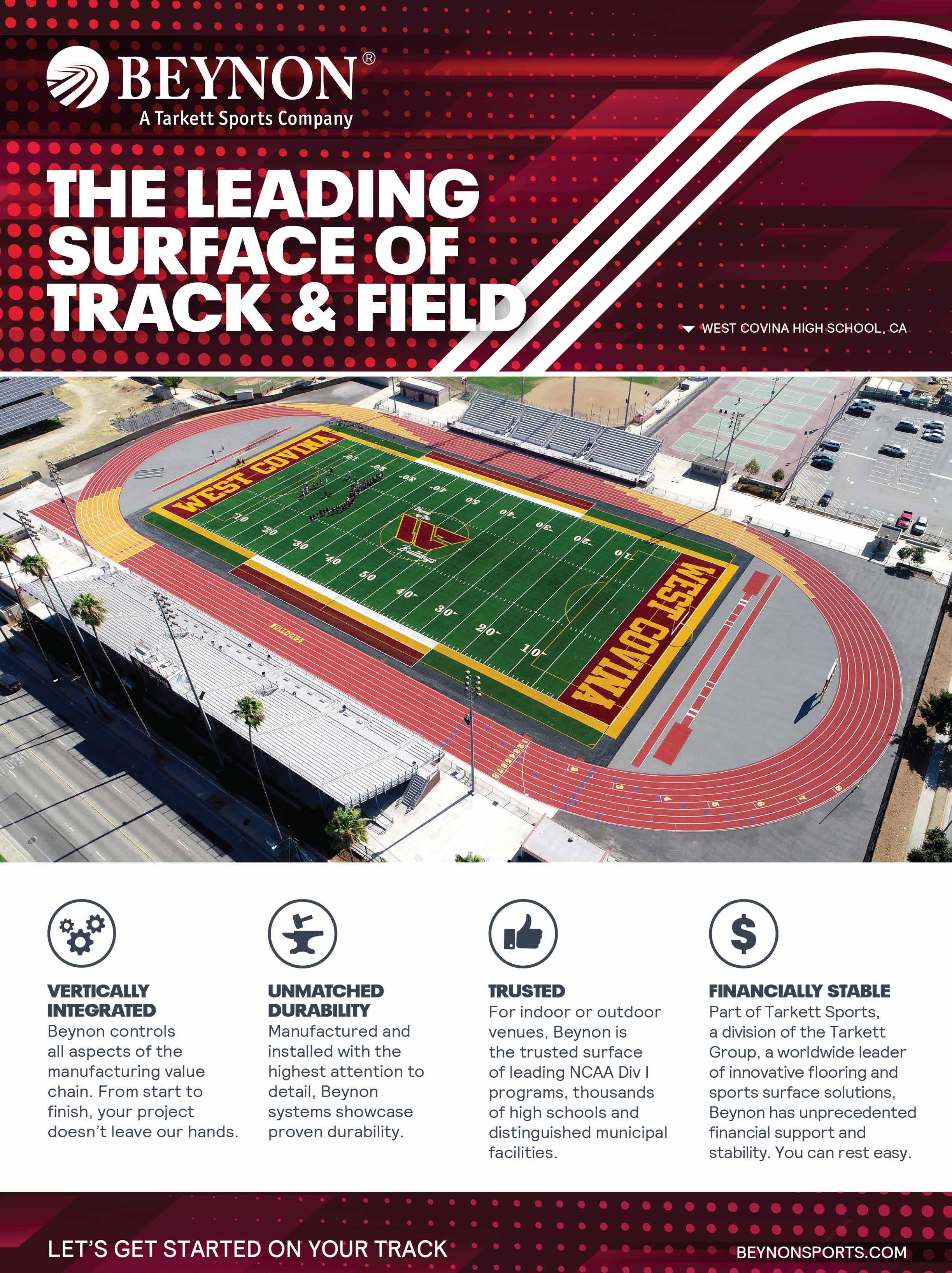




 BY BOB MYERS
BY BOB MYERS













































































































